Prevention and Treatment of HIV/AIDS Expository Essay
Introduction.
HIV/AIDS has become a concern to everybody in the world. Many countries and individuals have found it very hard to deal with it because of the lack of funds. Therefore, organizations have come up to help them handle this problem. Notable organizations that have offered their support include WHO, PEPFAR, the Clinton’s AIDS Initiative, the Gates Foundation and the Global Fund.

WHO HIV/AIDS Treatment and Prevention Program Policy
The World Health Organization Department of HIV/AIDS provides normative and policy support to its members basing on enough evidence ( WHO | Guidelines, 2014). The purpose of this support is to improve the treatment, care provision and prevention services ( WHO | Guidelines, 2014).
The global vision of WHO is to eradicate HIV infections, deaths and discrimination against infected people. It aims at attaining universal and comprehensive HIV prevention, treatment and care. It also aims at combating HIV/AIDS, malaria and other diseases ( WHO | Guidelines, 2014). WHO developed strategic directions that health units should adopt in achieving its goals. They are:
- Optimizing the prevention, diagnosis and provision of care for HIV victims ( WHO | Guidelines, 2014)
- Leveraging wider outcomes in health through appropriate response to HIV ( WHO | Guidelines, 2014)
- Reducing susceptibility and getting rid of barriers to accessing services ( WHO | Guidelines, 2014)
The World Health Organization also proposes treatment and preventive methods that are specific to the needs of individual countries. Among the methods it proposes for the countries include the use of male and female condoms, male circumcision, antiretroviral therapy, prophylaxis and behavior change counseling ( WHO | Guidelines, 2014).
WHO also volunteered to expand HIV prevention methods in every country ( WHO | Guidelines, 2014). Currently, it has plans to develop a HIV prevention strategy based on national evidence and push for the creation of better prevention methods and interventions.
The Role of other Organizations
Global fund.
The Global Fund partners with governments, civil societies, the private sector and victims of AIDS, Tuberculosis, and malaria in 140 countries worldwide ( HIV/AIDS-The Global Fund, 2014). It spends over $4 billion every year on these partnerships. This support has greatly accelerated the rate at which the prevalence of AIDS reduces.
The fund was developed with the purpose of giving HIV victims financial support to reduce the rate of infections ( HIV/AIDS-The Global Fund, 2014). In addition, the Global Fund ensures that all infected people in the world can access antiretroviral therapy. By last year, the fund had helped 6 million victims of HIV get access to ARV ( HIV/AIDS-The Global Fund, 2014).
Its efforts have largely depended on the realization that ARV reduces the chances of HIV transmission by close to 90%. The Global Fund concentrates its services and support in areas where the effects of HIV/AIDS are more prevalent. It looks for geographic and demographic information, making it easier to focus on certain countries and populations around the world. It mostly focuses on stigmatized groups such as women, girls, drug users, migrant workers and inmates.
Gates Foundation
The main objective of the Gates Foundation is “to reduce the incidence of HIV infection and extend the lives of people living with HIV” ( HIV, 2014, par. 4). The organization offers support to all the efforts of reducing worldwide transmission of HIV. It also helps the victims of the virus live long and healthy lives.
The organization mainly focuses on populations living in Sub-Saharan regions of Africa. HIV has greatly affected the population in these regions ( HIV, 2014). These regions are very poor and cannot afford HIV medication without support. The foundation gives grants to organizations that fight HIV. It also offers financial support to the Global Fund.
So far, it has given approximately $2.5 billion to organizations in all countries and $1.4 billion to the Global Fund ( HIV, 2014). The foundation also advocates sustainability and increase in funding programs that aim at reducing HIV/AIDS prevalence.
The fund also supports the search for a HIV vaccine. It invests in research that aims at coming up with the vaccine. It partners with private institutions, individual researchers and governments in researching on several types of possible vaccines. It also provides antiretroviral therapy and other products such as vaginal rings and injections to the victims.
In addition to other activities, the foundation provides tools for carrying out voluntary male circumcision in 14 Sub-Saharan countries ( HIV, 2014). It also supports efforts by governments and other private institutions to diagnose and measure the prevalence of HIV.
Clinton’s AIDS Initiative
The Clinton Health Access Initiative was established with the purpose of helping all victims of HIV get access to medication and reduce its cost ( HIV/AIDS , 2014). Since its inception, the number of people accessing HIV medication has risen from 200, 000 in 2002 to over 8 million today ( HIV/AIDS , 2014).
In addition, the cost of the treatment has fallen from $ 10, 000 to approximately $100. The initiative has partnered with many countries around the world in formulating programs aimed at fighting HIV/AIDS ( HIV/AIDS , 2014). The best example of such partnerships includes the partnership with Ukraine.
This partnership aimed at increasing the access to HIV/AIDS treatment. President Clinton and Preval’s agreement to expand HIV/AIDS services and strengthen health systems in Haiti and the partnership with UNITAID that focused on reducing the prices of important AIDS medicine were also part of this initiative ( HIV/AIDS , 2014).
The main goal of PEPFAR is to save many lives through upgrading existing strategies and supporting efforts by different countries to improve their people’s health ( The U.S. President’s Emergency Plan for AIDS Relief, 2014). In 2008, the president of America signed an act that authorized the use of $ 48 billion in the fight against HIV, malaria and TB.
PEPFAR also aims at promoting sustainable AIDS eradication programs ( The U.S. President’s Emergency Plan for AIDS Relief, 2014). This initiative also supports countries in responding to HIV because of the belief that fighting AIDS is more effective when countries take charge of their affairs ( The U.S. President’s Emergency Plan for AIDS Relief, 2014). PEPFAR also focuses on other challenges that come with HIV/AIDS such as stigma and opportunistic diseases.
Recommendation
The organizations should provide more material support compared to money since most countries misuse the funds they receive.
Many countries in the Sub-Saharan Africa are too poor to provide good preventive and treatment methods of HIV/AIDS to their citizens. Close to 18% of their population is infected with the virus.
This situation has prompted many private and international organizations to come to their rescue. WHO, PEPFAR, the Clinton’s Organization and the Gates Foundation have provided support in these regions for a long time.
Private and International organizations have been very supportive in the fight against HIV/AIDS. Many countries and individuals could not afford the HIV/AIDS prevention and treatment without the support of PEPFAR, WHO, Clinton’s AIDS Initiative, Gates Foundation and other organizations. These organizations have invested lots of money and material support in regions with the most prevalent cases of HIV/AIDS.
HIV/AIDS (2014). Web.
HIV/AIDS – The Global Fund to Fight AIDS, Tuberculosis and Malaria (2014). Web.
HIV – Bill & Melinda Gates Foundation (2014). Web.
The U.S. President’s Emergency Plan for AIDS Relief: Five-Year Strategy (2014). Web.
WHO | Guidelines: HIV (2014). Web.
- Chicago (A-D)
- Chicago (N-B)
IvyPanda. (2023, November 2). Prevention and Treatment of HIV/AIDS. https://ivypanda.com/essays/prevention-and-treatment-of-hiv-aids/
"Prevention and Treatment of HIV/AIDS." IvyPanda , 2 Nov. 2023, ivypanda.com/essays/prevention-and-treatment-of-hiv-aids/.
IvyPanda . (2023) 'Prevention and Treatment of HIV/AIDS'. 2 November.
IvyPanda . 2023. "Prevention and Treatment of HIV/AIDS." November 2, 2023. https://ivypanda.com/essays/prevention-and-treatment-of-hiv-aids/.
1. IvyPanda . "Prevention and Treatment of HIV/AIDS." November 2, 2023. https://ivypanda.com/essays/prevention-and-treatment-of-hiv-aids/.
Bibliography
IvyPanda . "Prevention and Treatment of HIV/AIDS." November 2, 2023. https://ivypanda.com/essays/prevention-and-treatment-of-hiv-aids/.
- PEPFAR and Medicaid Nursing Programs
- Global Health Issues Affecting International Community
- Pharmacodynamics: Highly Active Antiretroviral Therapy
- HIV/AIDS and Orphans in Sub-Saharan Africa
- HIV/AIDS Prevention by Anti-Retroviral Drugs
- Drugs for the Treatment of HIV Infection: Over 30 Antiretroviral Drugs to Counter the Effects of the Deadly AIDS Virus
- Culture & Disease: Malaria in Sub-Saharan Africa
- Malaria in Women and Children in Sub-Saharan Africa
- Adherence to Antiretroviral Therapy Among HIV People
- Malaria and Poor Quality Drugs in Africa
- Duties of Health Care Professionals During Pandemic of Highly Contagious Diseases
- Prevention and Treatment of Tuberculosis
- Epidemiology: Genetics-Related Programs
- Leishmaniasis: Causes & Treatment
- HIV and AIDS Prevention Among the Youth in Asia
- Español (Spanish)
- HIV Prevention
The Basics of HIV Prevention
- Protect yourself during sex: To reduce your risk of getting HIV, use condoms correctly every time you have sex.
- Protect yourself if you inject drugs: Do not inject drugs . If you do, use only sterile injection equipment and water, and never share your equipment with others.
- Protect yourself taking PrEP: If you do not have HIV but are at risk of getting HIV, talk to your health care provider about pre-exposure prophylaxis (PrEP) . PrEP involves taking a specific HIV medicine every day or an injectable HIV medicine every two months to reduce the risk of getting HIV through sex or injection drug use.
- Protect others if you have HIV: Take HIV medicine (called antiretroviral therapy or ART) as prescribed by your doctor. ART can reduce the amount of HIV in the blood (called viral load) to the point where a test cannot detect it (called an undetectable viral load). If you have an undetectable viral load, you will not transmit HIV to your partner through sex.
- Prevent perinatal transmission: If you have HIV and take HIV medicine as prescribed by your doctor throughout pregnancy and childbirth, the chances of transmitting HIV to your baby are less than 1%. If you have a partner with HIV and are considering getting pregnant, talk to your doctor about PrEP to help protect you and your baby from getting HIV while you try to get pregnant, during pregnancy, or while breastfeeding.
How is HIV transmitted?
The person-to-person spread of human immunodeficiency virus (HIV) is called HIV transmission . People can get or transmit HIV only through specific activities, such as sex or injection drug use. HIV can be transmitted only in certain body fluids from a person who has HIV. Bodily fluids that can transmit HIV include blood, semen (“cum”), pre-seminal fluids (“pre-cum”), rectal fluids, vaginal fluids, and breast milk.
HIV transmission is only possible if these fluids come in contact with a mucous membrane, open cuts or sores, or are directly injected into the bloodstream (from a contaminated needle or syringe). Mucous membranes are found inside the rectum, the vagina, the opening of the penis, and the mouth.
In the United States, HIV is transmitted mainly by:
- Having anal or vaginal sex with someone who has HIV without using a condom or who is not taking medicines to prevent or treat HIV.
- Sharing injection drug equipment (“works”), such as needles or syringes, with someone who has HIV.
HIV can also be transmitted from a birthing parent with HIV to their child during pregnancy, childbirth (also called labor and delivery), or breastfeeding. This is called perinatal transmission of HIV. Perinatal transmission of HIV is also called mother-to-child transmission of HIV.
How is HIV not transmitted?
You cannot get HIV from:
- Casual contact with a person who has HIV, such as a handshake, a hug, or a closed-mouth kiss (“social” kissing).
- Contact with objects, such as toilet seats, doorknobs, or dishes used by a person who has HIV.
- Mosquitoes, ticks, or other biting insects.
- Other sexual activities that do not involve the exchange of body fluids (for example, touching).
- Donating blood or receiving a blood transfusion.
Use the You Can Safely Share…With Someone With HIV infographic from HIVinfo to spread this message.
How can I reduce the risk of getting HIV?
Anyone can get HIV, but you can take steps to protect yourself from HIV.
- Get tested for HIV. Talk to your partner about HIV testing and get tested before you have sex. Use the GetTested locator from the Centers for Disease Control and Prevention (CDC) to find an HIV testing location near you.
- Choose less risky sexual behaviors. HIV is mainly transmitted by having anal or vaginal sex without a condom or without taking medicines to prevent or treat HIV.
- Use condoms every time you have sex. Read this fact sheet from CDC on how to use condoms correctly .
- Limit your number of sexual partners. The more partners you have, the more likely you are to have a partner with poorly controlled HIV or to have a partner with a sexually transmitted infection (STI) . Both factors can increase the risk of HIV transmission.
- Get tested and treated for STDs. Insist that your partners get tested and treated, too. Having an STD can increase your risk of getting HIV or transmitting it to others.
- Talk to your health care provider about pre-exposure prophylaxis (PrEP). PrEP is an HIV prevention option for people who do not have HIV but who are at risk of getting HIV (for example, if your partner has HIV or if you inject drugs). PrEP involves taking a specific HIV medicine to reduce the risk of getting HIV through sex or injection drug use. PrEP medications can be given in the form of pills (taken daily) or injections (every other month). It is important to take PrEP as directed by your doctor to effectively protect you against HIV. For more information, read the HIVinfo fact sheet on Pre-Exposure Prophylaxis (PrEP) .
- Do not inject drugs. But if you do, use only sterile drug injection equipment and water, and never share your equipment with others.
How can I prevent passing HIV to others if I have HIV?
Take HIV medicines as directed by your doctor. Treatment with HIV medicines (called antiretroviral therapy or ART ) helps people with HIV live long, healthy lives. ART cannot cure HIV, but it can reduce the amount of HIV in the body (called the viral load ). One of the main goals of ART is to reduce a person's viral load to an undetectable level.
An undetectable viral load means that the level of HIV in the blood is too low to be detected by a viral load test . People with HIV who maintain an undetectable viral load by taking ART consistently as prescribed have effectively no risk of transmitting HIV to an HIV-negative partner through sex.
Remember, taking HIV medicines does not prevent transmission of other STIs.
In addition to maintaining an undetectable viral load, here are some other steps you can take to make sure you prevent HIV transmission to others:
- Use condoms correctly every time you have sex.
- Talk to your partner about taking PrEP.
- If you inject drugs, do not share your needles, syringes, or other drug equipment with other people.
Are HIV medicines used at other times to prevent HIV transmission?
Yes, HIV medicines are also used for post-exposure prophylaxis (PEP) and to prevent perinatal transmission of HIV.
- Post-exposure prophylaxis (PEP) PEP means taking HIV medicines within 72 hours after a possible exposure to HIV to prevent HIV infection. PEP should be used only in emergency situations. It is not meant for regular use by people who may be exposed to HIV frequently. For more information, read the HIVinfo fact sheet on Post-Exposure Prophylaxis (PEP) .
- Prevention of perinatal transmission of HIV Pregnant people with HIV take HIV medicines for their own health and to prevent perinatal transmission of HIV (HIV can be passed from a person with HIV to their child during pregnancy, childbirth, or breastfeeding). After birth, babies born to people with HIV receive HIV medicine to protect them from infection with any HIV that may have passed from mother to child during childbirth. For more information, read the HIVinfo fact sheet on Preventing Perinatal Transmission of HIV .
This fact sheet is based on information from the following sources:
- HIV Transmission
- PrEP (Pre-Exposure Prophylaxis)
- PEP (Post-Exposure Prophylaxis)
From the NIH Office of AIDS Research:
- Antepartum Care for Individuals With HIV: Overview
- Management of Infants Born to People with HIV Infection: Antiretroviral Management of Newborns with Perinatal HIV Exposure or HIV Infection
Also see the HIV Source collection of HIV links and resources.
Basic Information on Prevention

Today, more tools than ever are available to prevent HIV. You can use strategies such as abstinence (not having sex), never sharing needles, and using condoms the right way every time you have sex. You may also be able to take advantage of HIV prevention medicines such as pre-exposure prophylaxis (PrEP) and post-exposure prophylaxis (PEP). If you have HIV, there are many actions you can take to prevent transmitting HIV to others.
This section answers some of the most common questions about HIV prevention.
HIV Prevention Topics
Protect Yourself During Sex
Protect Yourself If You Inject Drugs
Protect Others If You Have HIV
Prevent Perinatal Transmission
Other HIV Prevention Methods
Download HIV Prevention Materials
Other resources.
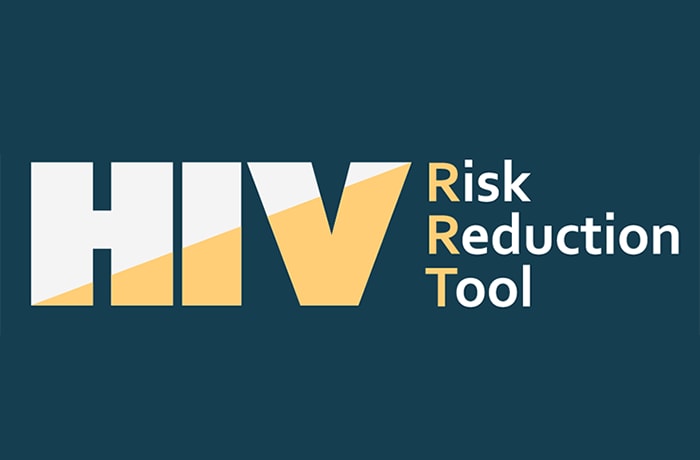
Get tailored information about your risk and learn how to protect yourself.

Download resources from the Let’s Stop HIV Together campaign.
- HIV by Group
- HIV Risk and Prevention
- HIV Nexus: Resources for Clinicians
- HIV Public Health Partners
- HIV Resource Library
- HIV Statistics Center
- About the Division of HIV Prevention
- VIH en Español
- @StopHIVTogether
- Get Email Updates
- Send Feedback
Exit Notification / Disclaimer Policy
- The Centers for Disease Control and Prevention (CDC) cannot attest to the accuracy of a non-federal website.
- Linking to a non-federal website does not constitute an endorsement by CDC or any of its employees of the sponsors or the information and products presented on the website.
- You will be subject to the destination website's privacy policy when you follow the link.
- CDC is not responsible for Section 508 compliance (accessibility) on other federal or private website.

Prevention Of Hiv / Aids Essay
The theories, interventions and strategies currently used to treat individuals diagnosed with HIV/AIDS involve several factors as it relates to a chronic disease. According to Auslander & Freedenthal in Gehlert & Browne (2012), HIV/AIDS is a chronic disease that once diagnosed, requires adherence to complex and challenging treatment regimens. Prevention of this disease requires changes in behavior that would lead to the reduction of less risky sexual behaviors. Harm reduction is a particular treatment approach that is used with HIV / AIDS individuals. As stated by Straussner (2014), Harm reduction treatment is both a philosophy and treatment approach. It was adapted in the United States in the 1980’s to minimize the transmission of HIV among injection drug users. Clean needles were distributed to injection drug users to reduce the spread of HIV/AIDS The combination of drug medications is another form of intervention used to treat HIV/AIDS. Highly Advanced Antiretroviral Therapy (HAART) is a multi – drug approach or drug cocktail used to treat HIV/AIDS. This form of intervention was effective in the risk reduction of both HIV/AIDS as it was able to provide durable suppression in the infected person. Cichocki (2016), states that HAART is now being used to reverse infection rates in high-risk populations, and has been shown to reduce the risk of HIV illnesses by as much as 58%. Treatment as Prevention (TasP) is another strategy used and has shown a decrease in the
Essay on Epidemiology and Communicable Diseases: HIV
HIV or the Human Deficiency virus is like other viruses including the flu, but the one thing that makes this virus so different than any other is that the body is unable to clear this one out completely. Once someone is infected, there is no cure. Over time, HIV can also hide or mask itself in the body's cells. The cells within a person's body that fight off infection are called CD4 cells or T cells. HIV attacks these cells and copies or replicates itself inside these cells, then destroys them. HIV over time will destroy so many of these cells that the body is unable to fight off infection anymore. When this starts happening, AIDS or Acquired Immunodeficiency Syndrome happens which is the final stage
HIV And HIV : Prevention And Prevention Of HIV
HIV (human immunodeficiency virus) infection is a long-term (chronic) viral infection. HIV kills white blood cells that help to control the body's defense system (immune system) and fight infection. HIV spreads through semen, pre-seminal fluid, blood, breast milk, rectal fluid, and vaginal fluid. HIV is commonly spread through sexual contact and sharing needles or syringes, because these behaviors involve exchanging bodily fluids. Without treatment, HIV can turn into AIDS (acquired immunodeficiency syndrome), an advanced stage of HIV infection. AIDS is a very serious illness and can be life-threatening.
Hiv / Aids Research Paper Essay
Human Immunodeficiency Virus is HIV that develops into AIDS, which is Acquired immunodeficiency syndrome. This virus starts to break down white blood cells, as a result the immune system starts to deteriorate and our greatest shield cannot fight any longer (Mayo Clinic, 2016). The CDC (2015) states, that over 1.2 million people live with HIV in the United States and most who are infected are oblivious of their disease. Healthy people 2020 has declared HIV a public health crisis in the United States, and continues to sweep the nation with more than 500,000 new cases each year (HealthyPeople2020,2016).
Battle Against Hiv / Aids Essay
HIV/Aids pandemic is high in South Africa as compared to any other country in the world. Recent statistic show that 12% of South Africa’s population lives with the virus and including young children the percentage rises to 18% of the total population. Other neighboring countries such as Botswana also have high prevalence rates and this means that almost all southern African countries rank top among the most infected nations not only in Africa but the world around. In the past few years the number of south Africans being diagnosed of HIV has been rising and even though the infections among adolescents particularly male have been dropping the damage this infection is causing remains substantial both socially and economically. Based on demographic grouping the most infected are females below the age of 40. And of the females infected about 80% are aged between 20-24 years. Infection among males stands below 40% with those aged above 30 years being the most infected. The fact that aids is high in South Africa more than any other country in Africa makes it necessary to understand the reasons behind it. Steinberg (2008) in his book “Sizwe 's test: a young man 's journey through Africa 's AIDS epidemic” fails to understand why many people still die in south Africa despite the emergence of antiretroviral drugs. He however realizes that “stigma” remains the greatest challenge in as far as HIV/AIDS is
The History Of Hiv And Aids Essay
In the 1980s, a mysterious disease began to take the lives of Americans. With the cause unknown, a fear grew among Americans. An unusually high rate of people was becoming sick with strange and rare diseases. When experimental treatments failed to work, people died. This mysterious disease is what we now know as HIV–Human Immunodeficiency Virus. In the past thirty-five years, the HIV has taken many turns in history. Although we do not hear about HIV and AIDS now, it is still a prevalent issue in the United States and in the world.
What Is Harm Reduction?
The strategy of harm reduction is based on “aggressive law enforcement and pressure on producer nations” (Abadinsky, 2014). As of the present, harm reduction is focuses on the problem and spread of HIV through drug needles (Abadinsky, 2014). Harm reduction does not focus on the prevention of drug use, but rather the harm that is done to the community and user, and wanting to reduce the amount of harm (Abadinsky, 2014). There is acceptance to programs or policies that help with harm reduction (Abadinsky, 2014). Throughout professional who assist in harm reduction, there has not been an agreement on a definition, but it is agreed with drug use is a fact and drug use will continue while focusing on reducing harm (Abadinsky, 2014). There are five
Kaposi's Sarcoma, Endemic: Article Analysis
After reading the five given articles carefully there are critical points that I would like to articulate in my reaction paper. These articles provoked me to think that we are blessed to have health professional that were able to discover HIV/AIDS and the causes of Kaposi 's Sarcoma and Pneumocystis pneumonia of homosexual men in July 1981, following the report of these cases of PCP and cases of other rare life-threatening opportunistic infections and cancers in America we began to recognize the importance of being aware of HIV/AIDS (Altman). Maybe not need
Prevention Of The Disease Aids Essay
Diseases have been affecting the globe for decades. In recent years there have been many infectious diseases have been occurring and spreading across society. Out of the many infectious diseases, there are two that are going to be examined. The two diseases that are going to be analyzed and reviewed are Ebola and AIDS. The two diseases have a high rate of death among people who have been infected. The right rate of death has occurred for decades. Both of these diseases are highly effective at attacking the immune system of the victims. These diseases are both infectious, but are different in several ways. In order to understand how to treat or contain these two diseases, it is informative to be educated on each disease, how it is spread, and what symptoms are prevalent.
Hiv / Aids Throughout Sub Saharan Africa Essay
According to the Centers for Disease Control and Prevention, the majority of people in the world living with HIV/AIDS reside in Sub-Saharan Africa. Since there is currently no vaccine to prevent the spread of the infection, there have been countless attempts in the past to control the spread of HIV/AIDS in Sub-Saharan Africa. There are multiple ways of infection spread in Sub-Saharan Africa. People are contracting the disease through, drug use, sexual relations, giving birth, and blood-to-blood contact. With so many ways to contract the infection it makes the prevention of spreading the infection so difficult, especially in such a low-income country. These challenges have not stopped many scientists, educators, and health-care professionals create interventions to try and stop the wildfire, that is the spread of HIV/AIDS in Sub- Saharan Africa. Most interventions have failed and some have helped. There are a huge amount of factors that need to be carefully thought about when creating an intervention. What looks good on paper may not work for the culture of a country. Making all people in sub- Saharan Africa listen, understand and act on a plan is nearly impossible.
Abstinence, Condom, And Health Promotion Related Prevention Of Stis / Aids Essay
I believe, the title had lacked detail on one of its main focus. When I initially read the title I would have never known that HIV/AIDS was a focus. My title preference would be, “Sexual Safety and Risks including HIV/AIDS, Among African American men who have sex with women”. I assumed the article would focus on abstinence, condom usage, and health promotion related to prevention of STIs.
AIDS: The Modern Day Epidemic Essay
- 9 Works Cited
Did you know that if a straight line of pennies was made down any given road, extending one mile, there would be over a hundred thousand dollars worth of change on the street? Dimes? Well over a million dollars. How about something that hits closer to home, something like lives? In 1996, when the AIDS pandamenic was at its peak, a memorial quilt made of individual panels about six feet by three feet in size was displayed in Washington D.C. Each square of the quilt represented a single victim whose life was claimed by the disease. Though many of the panels give only the victim’s name and birth/death dates, others included more personal items such as a pair of jeans, a teddy bear, or even a poem. Though there
Hiv Type 1 Research Paper
The medicines are often used together in combination to reduce the amount of HIV in the body. When different drugs are combined with the purpose of reducing the amount of HIV in the blood to very low levels, the resulting treatment regimen is called highly active antiretroviral therapy (HAART). The medicines that are commonly used during HAART are:
Hiv-1 Essay
HIV-1’s ability to mutate rapidly has hindered researchers to finding an effective vaccine. The characteristics of bNAbs show that it can target the surface of the virus to reduce the chance of an infection. A recent finding of calves being able to produce antibodies similar to bNAbs when exposed to the virus has provided a glimpse of hope, however further trials will still need to be carried out to initiate the same response in humans. Nonetheless, government funding has helped researchers to find a cure against HIV-1 by incorporating bNAbs into a vaccine.
HIV and AIDS Essay
HIV is the human immunodeficiency virus that causes AIDS. A member of a group of viruses called retroviruses, HIV infects human cells and uses the energy and nutrients provided by those cells to grow and reproduce. AIDS (acquired immunodeficiency syndrome) is a disease in which the body's immune system breaks down and is unable to fight off certain infections, known as "opportunistic infections," and other illnesses that take advantage of a weakened immune system. When a person is infected with HIV, the virus enters the body and lives and multiplies primarily in the white blood cells. These are the immune cells that normally protect us from disease.
AIDS and HIV Essay
- 11 Works Cited
Currently, there are no vaccines and no cures for HIV or AIDS, although scientists are researching and finding new drugs and treatments. So far, scientists have discovered a variety of drugs and medication that can be used to control and slow the virus and the progression of the disease. There are some drugs which interfere with the virus ability to make copies of itself by disabling a protein it needs, like Non-nucleoside reverse transcriptase inhibitors. If someone is diagnosed with HIV, it is important to start with treatments as soon as possible.
Related Topics
- Antiretroviral drug
- Public health
HIV/AIDS: Prevention, Control, Treatment
Human immunodeficiency virus (HIV) is a global issue that can have a negative impact on healthcare and social dynamics. It leads to the development of acquired immunodeficiency syndrome or AIDS, which emerged during the last decades of the 20th century. It is a major epidemiological disease that severely damages an individual’s immune system. It can be manifested in a wide range of complications, such as malignant neoplasms or lesions. The given socio-medical problem is further complicated by the absence of effective medications that could protect or partly replace the immune system’s functional dimension. Another major pitfall is the lack of HIV targeted vaccines that could help people build a certain degree of immunity to the viral agent.
Moreover, HIV/AIDS is a social problem that impacts a specific set of vulnerable population groups. The latter includes drug addicts, female sex workers, homosexual males, African American males, and neighborhoods with high levels of poverty indicators. Therefore, one should be aware that AIDS is not the sole issue of medical experts but also policy makers, sociologists, and economists. The current approach of combatting the spread of the AIDS epidemic is based on the notion of “treatment as prevention.” The latter methodological framework primarily focuses on addressing a wide range of ramifications of the virus and ensuring safety among the vulnerable groups. Health education should be the main focus of healthcare organizations. From an epidemiological point of view, AIDS is an infectious disease of an anthropologic nature with contact and vertical transmission mechanisms. The source of infection is an infected person at any stage of the disease, that is, regardless of the clinical signs of the disease. The most intense transmission of the virus occurs during sexual contact with patients and virus carriers. Therefore, it is critical to understand the HIV from a medical and social perspective and derive plausible preventative measures.
Reworked Informative Papers
Medical aspect.
HIV is an agent that primarily targets specific cells of the human immune system, making the latter highly vulnerable to a wide range of other infections. It destroys the body by eliminating CD4+ T-helper lymphocytes, which are critical for the normal functioning of the immunity (Mandal, 2019). The effect of the virus can be observed throughout the body, where it disrupts one’s well-being. AIDS can be a key contributing factor to health issues, such as dementia, tongue trouble, seizures, depression, anxiety, kidney damage, diarrhea, or heart strain (Pietrangelo & Cherney, 2020). Therefore, it is evident that HIV is a unique virus that set a conditional risk of a person, where he or she might not directly suffer from the virus itself, but its ramifications.
It is important to note that virological research methods are used to detect the virus. The latter includes inoculation of blood or other material in tissue culture, electron microscopy, polymerase chain reaction (PCR). In practice, ELISA and immunoblotting reactions are widely used (Rushing, 2018). HIV is found in many cellular elements and fluids of sick and infected people, and blood and semen occupy a special place among them. Blood is the main springboard, where the processes that lead to the suppression of immunity, the main pathogenic mechanism of HIV infection, unfold. In addition, blood is known to play a leading role in the transmission of disease. HIV is found both in blood cells, mainly in lymphocytes, and in plasma and its fractions. Sperm is the main carrier of the virus in the spread of HIV infection. Until now, the possibility of HIV transmission by airborne droplets, through food or in any other way possible through close everyday communication, has not been proven (Rushing, 2018). The hypothesis of transmission by blood-sucking insects, expressed by some researchers, was not confirmed by verification work in the United States and Africa.
Transmission
The recognized modes of transmission of the disease are direct sexual contact, regardless of the method of its implementation, and blood and its preparations from infected donors, objects. In addition, the infection can pass through blood-contaminated sources of disease in the presence of small defects on the skin and mucous membranes. Vertical transmission is manifested through infections from the mother with AIDS and breast milk to the child. HIV transmission is also possible through intramuscular, intravenous and subcutaneous injections, medical scarification, and tattoos. Theoretically, it is possible to transmit the virus by airborne droplets, contact-household, oral-fecal, transmissible routes. The rare ways of spreading the virus include its transmission during ritual manipulations.
Social Aspect
It is important to understand that AIDS more of a social problem rather than a medical. The main reason is the lack of effective treatment procedures and vaccines, which only leaves the preventative options as a method of combatting the virus. HIV/AIDS epidemic has a severe negative impact on the economic growth of a nation due to the elevated level of spending on vulnerable groups and social instability. It is stated that HIV can become a major hindrance to the economic growth of West Africa (Dauda, 2018). In other words, AIDS is a major economic issue for both developed and developing nations due to the heaviness of the burden of having a large segment of the population infected by HIV. In addition, works devoted to the consideration of the political and legal context of the development of the HIV/AIDS epidemic in the world are important (Singer, 2018). The main reason that properly targeted policies and legislative procedures can reduce the risk factor among the vulnerable population.
Policymakers can design a wide range of programs that ensure the safety of these groups through the active provision or raising awareness through education. This is necessary not only for understanding the social processes associated with AIDS, but also for the development of effective prevention programs. Such activities can take the form of both general or group-specific manifestations, where the latter addresses pressing prevention issues of a particular group.
AIDS as a Social Problem
Social problems are an integral part of the social life of any society, and they are integrated into the social space and largely determine the vector of social development. In sociology, a whole independent direction has developed, associated with the analysis and understanding of social problems. Within the framework of the issue, one should focus on the concept of the social issues, which overcomes the contradictions between the objectivist and subjectivist directions in the theory of social problems and can serve as the basis for understanding the HIV/AIDS epidemic as a social problem. First, the concept of a social problem can be applied to social processes and conditions, which are perceived by the majority of the population as undesirable or threatening the basic values of society, such as social order, legality, moral norms, the stability of social institutions.
Secondly, accepted social agreements can be perceived as social problems if they contradict the interests of specific social, socio-demographic groups. Thirdly, social issues can be viewed as a sense of collective guilt caused by the awareness of public disregard for specific social phenomena and conditions, which, as a result, led to a negative impact on certain sectors of society. Fourth, the concept of social problems is applicable to physical, biological, and other natural phenomena, if adequate preventive measures are not taken to prevent destructive natural events. In addition, this is relevant if measures to eliminate the consequences of these phenomena are assessed by society as a whole or by individual communities as unsatisfactory. In addition, a distinctive feature of social problems is the possibility, at least potential, of its solution, and usually the responsibility for solving social issues are assigned to the state. Within the framework of this concept, it is possible to identify the conditions for classifying the phenomenon as a number of social problems. There is an identifiable social origin, a real or potential threat to social values and interests, and the possibility of resolving a problem situation.
If one observes AIDS from these positions, it becomes evident that AIDS is a social problem, and AIDS is characterized by all the variety of manifestations of social issues. The spread of HIV/AIDS threatens the basic value, that is, human life. In addition, the AIDS epidemic negatively affects the demographic and economic situation. Due to the disease, many legal and social norms have required revision. For example, the latter applies to groups such as homosexuals, drug users, and sexuality education, including schooling. In addition, female sex workers are among the most vulnerable groups due to their capability to infect individuals both vertically and horizontally (Shannon et al., 2015). The state and society as a whole are responsible for the spread of HIV infection, especially for the appearance of children with HIV-positive status. In this regard, evidently, there should be a sense of collective guilt because the state is responsible for combating the epidemic.
When considering HIV/AIDS as a social problem, it is necessary to say a few words about the constructionist approach to the obstacle of AIDS. However, for all the weaknesses of targeted civil society institutions in relation to AIDS, the situation was not so clear-cut. The construction of AIDS as a social problem took place with active participation, including financial, from the international community and international structures (Rushing, 2018). The activities not only drew attention to the AIDS problem but also contributed to the creation of a significant number of non-governmental organizations in the country.
Current Social Structure
Such actions are aimed at the implementation of preventive projects and have a gradual impact on the change in the state’s position on the prevention of HIV/AIDS. This is particularly relevant in relation to syringe exchange for drug users. Of course, the mass media controlled by the authorities can misinterpret the AIDS problem. Many sites are devoted to HIV/AIDS, and therefore, it should be taken into account that the Internet occupies a significant place in the information space of modern society (Rushing, 2018). In addition, it can be argued that from a constructionist standpoint, despite the strategies used to de-problematize the situation with the spread of HIV infection, it is also a social problem.
The variety of social issues related to the AIDS phenomenon, in turn, requires a multifaceted preventive work. In this regard, it is quite legitimate to talk about the social prevention of HIV/AIDS, meaning by it a change in the risky behavior of an individual. In addition, it is important to change group norms that encourage risky behavior and create a social structure. The latter concerns specifically social rules, legal framework, socio-economic conditions that support HIV/AIDS-safe behavior. Understanding the social problems associated with HIV/AIDS refers to contemporary sociological discussions (Rushing, 2018). They most often unfold around the transformation of society from modernity to developed modernity or postmodernity. In other words, it is a transformation from an industrial to a post-industrial society. This shift is associated with the transition from a community of certainty and rationality inherent in modernity to a culture of relativity and uncertainty that postmodernity presupposes. The basis of postmodernism in science has become a critical attitude to knowledge and relativism not only of scientific knowledge but also of value and normative structures.
Moreover, the factor of health and attitude to health also becomes structure-forming. The presence or absence of certain types of diseases becomes the basis of social differentiation. Moreover, these can be both socially acceptable and socially disapproved diseases. For example, conditions of the musculoskeletal system are accepted in society, and people with disabilities form a separate social stratum for which a whole infrastructure is being created and developed. Diseases associated with socially disapproving behavior in the public mind also affect the social structure of modern society. HIV has become a kind of structure-forming factor, singling out the community of HIV-infected people into an independent social community of contemporary society.
Community and Risk
The peculiarity of modern society is in the threat of danger, which does not recognize the protection zones and differentiation of today’s world. The continuation of life and the recognition of risk come into conflict with each other, and this circumstance gives existential acuteness to disputes about the results of measurements and limit values, about short-term and long-term consequences. In order to remove the restrictions due to origin, and give a person the opportunity to make decisions for himself or herself and by the labor to secure a place in the social structure, a new variety appears in the developed modernity. AIDS, along with human-made risks, belongs to the group of threats and dangers that, although unevenly distributed in the global social context, nevertheless, for them, the borders of national states are transparent, permeable, and surmountable. The community of fear based on risk is a new socio-psychological community, a neighborhood of world social movements, and an adequate policy should be the only interstate.
Awareness of all this prompts many modern social analysts to evaluate the post-industrial society that is emerging as a society of risk. The risk of HIV infection is one of the main dangers today. At the same time, despite the fact that HIV infection threatens the entire population in a risk society, it is quite legitimate to talk about risk groups, more precisely about groups vulnerable to HIV infection. In other words, these are risk behavior groups in which HIV-risk behaviors are regularly practiced, namely, injecting drug use or unprotected sexual relations.
The AIDS epidemic does not spread equally, and there are a number of groups who are affected in a disproportionate manner. One should be aware of the fact that the majority of HIV infections take place through two main activities. The latter includes drug injection and sexual contact, where both involve the transmission of HIV infected fluids, such as blood and sperm (Brawner et al., 2017). In other words, the preventative measures need to utilize behavioral interventions, which are specifically targeted at reducing the occurrence rate of risk behaviors. In such cases, society sooner or later has to abandon outdated stereotypes of thinking and change prohibitive legislation and discriminatory policies that hinder the fight against the epidemic in order to save the lives of its citizens (Saha & Samanta, 2019). The objective and procedural components include supporting the vulnerable groups’ education and training.
Primarily, actions that are required by the AIDS epidemic conflict with existing ideas about public health and morality. It can also be supplemented by a wider and more generalist approach, such campaigns designed to raise awareness regarding the AIDS epidemic. High poverty neighborhoods tend to suffer from the AIDS epidemic more severely compared to other locations (Wiewel et al., 2017). It is stated that the only approach to stop the overall spread of HIV is based on the concept of “treatment as prevention” (Schwetz & Fauci, 2019). The latter statement means that without an effective vaccine or treatment process, the only plausible solution is the prevention of the spread by making people avoidant of risk behaviors that lead to transmission of HIV.
However, one should note that it is highly intricate and challenging to change the behavioral pattern of drug users and sexually active individuals. The former problem mainly involves a certain form of addiction, whereas the latter intervenes in one privacy and intimacy. The preventative barriers can also emerge at different levels, such as individual, community, society, religion, culture, and government policy. All these factors further complicate the issue by making each location unique and requiring more specific steps. For example, education and prevention efforts aimed at the heterosexual transmission of HIV should also take into account the sexual culture of heterosexual men.
It is highly important to change risky behavior, where the task of prevention is to convince people voluntarily and for a long time to change their behavior, making it safer. There are a number of psychological patterns of behavior change. Voluntary abandonment of stable habits, as a rule, does not occur immediately but is a more or less lengthy process, during which a person goes through several stages. To reduce the spread of HIV infection, injecting drug users must be given choices. One needs to either stop using or switch to strategies to reduce the risk of drug use or reduce the harm caused by drugs.
It should be noted that it is unrealistic to demand that all drug addicts immediately give up drugs. At each stage, the person changing their behavior needs appropriate information and support. This area of prevention is especially important for countries with an opioid crisis, as most new HIV infections occur through injecting drug use. A significant proportion of infections occur in the sexual partners of drug users, as well as in children born to HIV-positive mothers who have used drugs or become infected from a drug-dependent partner.
Prisoners represent a mixed group at increased risk of HIV infection, who also pose a group with restrictions on access to health care and information. Along with these contingents, some other population groups are at increased risk of infection. These include, for example, people who constantly change their place of stay, that is, various kinds of travelers and migrants. These same groups may have limited access to prevention activities compared to local populations. Men who have sex with men have historically been considered particularly vulnerable to HIV infection. In addition to homosexual men who have sex exclusively with men, this group also includes bisexual men who have both homosexual and heterosexual relationships.
Stigma and Support
Stigma and discrimination against this group are common factors that hinder effective prevention. Any elements of homophobia that penetrate information materials can lead to the fact that such people will react negatively to information useful to them. Traditionally, it is believed that the greatest effect in the field of HIV prevention among LGBT people can be achieved by attracting representatives of the group themselves, acting directly in this closed community, to this work.
All citizens of the country, regardless of belonging to a particular social group, must be guaranteed access to preventive services, medical care, care, and support for HIV infection. Prevention and treatment of HIV infection among representatives of vulnerable groups such as drug addicts, sex workers, convicts serving sentences in prisons are also aimed at improving public health in general (Goldenberg et al., 2016). In addition, African American males living in rural regions are also prone to get infected with HIV (Kogan et al., 2016). In order to successfully combat the spread of HIV infection among injecting drug users, it is necessary to combine preventive measures with ensuring broad access to antiretroviral therapy for vulnerable groups. This is done in conjunction with medical and social support, harm reduction, and treatment adherence programs. In order to reach such hard-to-reach social groups as injecting drug users, various activities are carried out within the framework of harm reduction programs. The latter may include information and counseling for injecting drug users, including peer educate peer education and the provision of free condoms.
In addition, there is an exchange of used injecting equipment for sterile needles and syringes, as well as facilitated access to health care and social services. Reaching outreach to injecting drug users is usually undertaken by health care professionals and community organizations, with the involvement of peer educators. They provide direct contact with the target group during street social work. This work helps to attract clients to harm reduction programs, provides information on safe practices to those who do not attend such programs. To offer all needy injecting drug users with the necessary assistance in harm reduction projects, health, and social services for this category are provided with low thresholds. In other words, they are easily accessible services where the client receives assistance in the most convenient form, depending on his or her needs. The organization of low-threshold services is based on principles such as anonymity and convenient working hours. In addition, a convenient location, free provision of services, and respect and friendly attitude towards the client from the staff are important.
The provision aspect of AIDS prevention is focused on reducing the instances of risky behaviors, such as needle sharing among drug injectors. It is critical to provide the given group of the vulnerable population proper access to sterile equipment. The latter ensures that one will not transmit HIV through blood elements, where the virus resides. Although there are syringe and needle provision programs in many nations, they need to be expanded in scale through funding and more deliberate approaches (Rushing, 2018). In other words, despite having such programs, the current awareness and accessibility level is low. The vulnerable group is most likely to be unaware of this support network or they do not have access to the provided benefits.
Most of those in need of treatment is outside the field of vision. These are mainly injecting drug users, for whom access to medical services is difficult. There is no effective coordination between various structures in the procurement of medicines in the regions; stability of supply is not always ensured. Infrastructure development, such as specialized health care facilities, is lagging behind the increased needs and capacity to provide treatment.
Mechanisms of interaction between various medical and social programs are not debugged. For example, these are AIDS prevention and control centers, drug treatment dispensaries, tuberculosis dispensaries, and harm reduction programs. In light of the above facts, it is necessary to focus efforts on HIV prevention and treatment among vulnerable groups in some areas. It is important to understand the coordination of efforts and partnerships and funding for human rights. A number of international projects working in the country were called upon to change the HIV situation. It is challenging to convey life-saving information to those to whom it is intended, and even more difficult to induce these people to change their habitual behavior. For this, campaigns are held, preventive materials are issued, and comprehensive programs are developed. One-off events, such as a charity concert or telethon, are valuable because they draw public attention to an issue and enable famous, popular, and powerful people to express their feelings about it. Successful campaigns help raise funds to fight the epidemic. However, such an action is not able to really change the daily behavior of people. This requires a long-term and targeted prevention program.
In conclusion, the human immunodeficiency virus is an agent that weakens an individual’s immune system by eliminating T-helper cells. Such an occurrence leads to the development of AIDS, which is a condition where a person has severely hindered immunity to the majority of infections. Although HIV does directly kill an affected body, it creates a situation where a number of different health complications emerge. It is important to understand that there are a limited number of ways HIV can be transmitted between individuals. The latter includes both vertical, such as mother to child, and horizontal transmission types, such as unprotected sexual intercourse and blood-to-blood contact. Therefore, the vulnerable groups include female sex workers, homosexual males, African American males, communities with a high degree of poverty, and, most importantly, drug users. The latter group is primarily affected due to needle or syringe sharing, which directly transfers blood particles from one individual to another.
The overall prevalence of AIDS among drug injectors can be prevented through a wide range of social programs that imposed targeted policies. Such programs need to be focused on provision measures, such as providing sterile needles and syringes to drug addicts in order to slow down the HIV spread. In addition, unprotected sex and other transmission types can be addressed through an educational approach, which can be comprised of deliberate training. Mass campaigns designed to raise awareness among the public can also be effective at delivering the critical message of risks regarding AIDS and its connection with unprotected sex.
Lastly, the most intricate issue is the vertical transmission of HIV from mother to child. It requires special attention because there is a strong need for cooperation between social workers and women affected by AIDS. The preventive measures should utilize monitoring procedures, where the target group is constantly accompanied by relevant specialists, such as experts from AIDS control and prevention centers and obstetrician-gynecologists. Therefore, one can clearly observe that AIDS is a socio-economic problem that needs a substantial budget or resource allocation.
Brawner, B. M., Guthrie, B., Stevens, R., Taylor, L., Eberhart, M., & Schensul, J. J. (2017). Place still matters: Racial/ethnic and geographic disparities in HIV transmission and disease burden. Journal of Urban Health, 94 , 716-729.
Dauda, R. S. (2018). HIV/AIDS and economic growth: Evidence from West Africa. The International Journal of Health Planning and Management, 34 (1), 324-337.
Goldenberg, S. M., Brouwer, K. C., Jimenez, T. R., Miranda, S. M., & Mindt, M. R. (2016). Enhancing the ethical conduct of HIV research with migrant sex workers: Human rights, policy, and social contextual influences. PLOS ONE, 11 (5).
Kogan, S. M., Cho, J., & Oshri, A. (2016). The influence of childhood adversity on rural black men’s sexual risk behavior. Annals of Behavioral Medicine, 50 , 813-822.
Mandal, A. (2019). AIDS pathophysiology.
Pietrangelo, A., & Cherney, K. (2020). The effects of HIV on your body. Healthline.
Rushing, W. A. (2012). The AIDS epidemic: Social dimensions of an infectious disease . Sage.
Saha, S., & Samanta, G. P. (2019). Modelling and optimal control of HIV/AIDS prevention through PrEP and limited treatment. Physica A: Statistical Mechanics and its Applications, 516 , 280-307.
Schwetz, T. A., & Fauci, A. S. (2019). The extended impact of human immunodeficiency virus/AIDS research. The Journal of Infectious Diseases, 219 (1), 6-9.
Shannon, K., Strathdee, S. A., Goldenberg, S. M., Duff, P., Mwangi, P., Rusakova, M., Reza-Paul, S., Lau, J., Deering, K., Pickles, M. R., & Boily, M. C. (2015). Global epidemiology of HIV among female sex workers: Influence of structural determinants. The Lancet, 385 (9962), 55-71.
Singer, M. (2018). The political economy of AIDS . Routledge.
Wiewel, E. W., Borrell. L. N., Jones, H. E., Maroko, A. R., & Torian, L. V. (2017). Neighborhood characteristics associated with achievement and maintenance of HIV viral suppression among persons newly diagnosed with HIV in New York City. AIDS and Behavior, 21 , 3557-3566.
Cite this paper
- Chicago (N-B)
- Chicago (A-D)
StudyCorgi. (2022, January 25). HIV/AIDS: Prevention, Control, Treatment. https://studycorgi.com/hiv-aids-prevention-control-treatment/
"HIV/AIDS: Prevention, Control, Treatment." StudyCorgi , 25 Jan. 2022, studycorgi.com/hiv-aids-prevention-control-treatment/.
StudyCorgi . (2022) 'HIV/AIDS: Prevention, Control, Treatment'. 25 January.
1. StudyCorgi . "HIV/AIDS: Prevention, Control, Treatment." January 25, 2022. https://studycorgi.com/hiv-aids-prevention-control-treatment/.
Bibliography
StudyCorgi . "HIV/AIDS: Prevention, Control, Treatment." January 25, 2022. https://studycorgi.com/hiv-aids-prevention-control-treatment/.
StudyCorgi . 2022. "HIV/AIDS: Prevention, Control, Treatment." January 25, 2022. https://studycorgi.com/hiv-aids-prevention-control-treatment/.
This paper, “HIV/AIDS: Prevention, Control, Treatment”, was written and voluntary submitted to our free essay database by a straight-A student. Please ensure you properly reference the paper if you're using it to write your assignment.
Before publication, the StudyCorgi editorial team proofread and checked the paper to make sure it meets the highest standards in terms of grammar, punctuation, style, fact accuracy, copyright issues, and inclusive language. Last updated: October 29, 2022 .
If you are the author of this paper and no longer wish to have it published on StudyCorgi, request the removal . Please use the “ Donate your paper ” form to submit an essay.
Talk to our experts
1800-120-456-456
- Essay on AIDS

HIV (human immunodeficiency virus) is an infection that causes cells in the body that help it fight infections, making a person more susceptible to other infections and diseases. Interaction with certain bodily secretions of an HIV-positive individual, most commonly during unprotected intercourse (sex without the use of a condom or HIV treatment to prevent or treat HIV), or sharing injection drug equipment spreads the virus.
If HIV is not treated, it can progress to AIDS (acquired immunodeficiency syndrome). HIV cannot be eradicated by the human body, and there is no effective HIV cure. As a result, whether you have HIV, you will have it for the rest of your life.
Long and Short AIDS Essay in English
There are many diseases causing microorganisms, like bacteria, viruses, fungi etc. The symptoms of the diseases depend on the type of microorganism that is spreading it. It can vary from mild to severe. AIDS which stands for Acquired Immunodeficiency Syndrome is a viral disease that is rampant in growth. It was only in the last century that this viral disease has proved to be lethal and fatal, taking away about twenty million lives globally. The awareness about the disease and the virus causing it which is HIV or Human Immunodeficiency Virus is more now compared to earlier. In this HIV AIDS essay, we can go through the important information about it and burst some myths.
Below are different ways to write an AIDS essay in English. The essay on HIV AIDS can be of 2 formats, a long essay on HIV AIDS or a short AIDS essay.
Short Essay on Aids
This AIDS essay is a brief one and will cover the important notes about the disease and the ways one can prevent it.
The way of occurrence of this disease is in the name itself, AIDS stands for Acquired Immunodeficiency Syndrome. The disease is acquired via the virus which is called Human Immunodeficiency Virus. It is not an auto-immune disease in the early stages of infection where the immune system in the body fights off infection to protect the body from diseases that go against itself. The virus enters from an outside source and destroys the efficiency of our immune system.
AIDS is transmitted through contact. The contact with infected blood of the HIV OR AIDS patient in any form can easily transfer this viral disease. It can also be transmitted through contact with semen or vaginal fluids of the infected person. This occurs in the case when one is sexually exposed to a person with HIV.
HIV once enters the body, invades and conquers the immune system making the body susceptible to other diseases. It is then very easy for the simple flu or cold infection to be severe as the immune system is no longer fit to fight it.
When detected in the early period can be battled with, but more often than not people assume the symptoms to not be AIDS so it spreads and kills the individual. To be protected when having sex and not sharing any form of toiletries with others is the way to prevent and keep this deadly virus at bay.
Long Essay on AIDS
This is the long format of an essay on HIV AIDS where its workings, causes and effects and remedies are discussed.
There are some diseases that have been borne by the living in this world which has created a ruckus in human history and the struggle to find a permanent cure still exists. AIDS is one such disease. Acquired Immunodeficiency Syndrome is the name of the disease which is also shortened as AIDS.
It has since only the 20 th century affected the human race and many people lost their lives, more than 20 million of them. The virus that aids in the transmission of this disease is Human Immunodeficiency Virus or also called HIV. Due to the same property of immunodeficiency, it is referred to as HIV/AIDS.
Since it affects the immune system severely, the cells and the workings of it in our body must be clearly understood. The immune system’s role in the body is that of a soldier wherein it identifies any sort of anomalies that enters or infiltrates the body and prepares antibodies against it. And kills them in order to prevent infection that has the probability of causing a harmful disease.
Since the cells of the immune system have already created the antibodies, the cell memory is activated when the entry occurs again and the immune system fights and destroys such foreign and harmful matter.
What Happens when HIV Enters the Body?
When a person is infected with the Human immunodeficiency virus, it directly attacks the immune system making the cells weak and incapable of creating antibodies for this particular virus. As they become weak their function to perform the task of defending against other microorganism entrants is also weakened.
When the fighter in our bodies becomes weak, we are more likely to fall ill. The illness can be a simple flu or an allergy and our body cannot fight any further. The symptoms once infected will start to appear within the first two weeks. The symptoms are very flu-like for instance, one will be more tired than usual and fatigue will be more frequent and regular. Other symptoms include sore throat and fever. The risk of opportunistic infections like tuberculosis and herpes also increases. Some people however remain asymptomatic even for longer periods after being infected with the virus.
Cause of HIV/AIDS
The main and only cause of this dreadful disease is the contact through blood, semen, pre-seminal fluid, vaginal fluids, rectal fluids and breast milk. The semen and vaginal fluids are transferred through sex and rectal fluids through anal sex. When people have multiple partners, and they have unprotected sex the transmission is highly likely. The contact through blood can also be via the unhygienic practice of sharing an infected person’s razors, blades. Even unsterilized syringes while taking drugs or even a tattoo parlor where they use unsterilized machines on the body can transmit the virus easily. The transmission means are endless so one must proceed with utmost caution to keep themselves safe either way.
What is the Life Expectancy for the Patients Carrying HIV or AIDs with Them?
Many factors can affect the life expectancy of people living with HIV. Depending on these factors there are many differences in the outcomes between people, and other factors. The factors on which life expectancy depend are:
Access to effective HIV treatment and quality health care.
Start HIV treatment as soon as possible after HIV infection, before your CD4 cell count drops to a low level. The sooner you are diagnosed and start HIV treatment, the better your long-term chances are.
Having serious HIV-related illnesses in the past. This may occur before HIV is diagnosed and/or before HIV treatment is started. These diseases have a detrimental effect on life expectancy.
Results one year after starting HIV treatment. Studies show that life expectancy is better for people who respond well within a year of starting treatment than people who do not respond. In particular, people with a CD4 count of at least 350 and an undetectable viral load during the year have a much better chance long-term.
Year of Diagnosis - HIV treatment and medical care have improved over the years. People who have been diagnosed in recent years are expected to live longer than people who were diagnosed long ago.
Heart diseases, liver diseases, cancer and other health conditions are more likely to be the cause of death than HIV or AIDs.
Injecting drug use - Life expectancy is short for people with HIV who inject drugs, due to drug overdose and viral infections.
Social and Economic Conditions - there are significant differences in life expectancy depending on where you grew up, your income, education, social status and more.
Gender – Men are supposed to live for a shorter period of time than women.
Genetics - you may have certain conditions if close relatives have.
Mental and Emotional Well-being - high levels of stress are associated with reduced life expectancy.
Lifestyle - longevity for people who eat a balanced diet, are physically active, maintain a healthy weight, avoid alcohol abuse or use drugs, and stay in touch with the community. Avoiding smoking is very important in life.
There are a few myths surrounding this disease. It is believed earlier that AIDS can spread even through contact or touch without any exchange of fluids. Like through a hug or just by being near the infected person. That myth has been debunked and it is absolutely untrue. One can freely hug an AIDS patient without worry.
The other one was when kissing, there is an exchange of saliva which is also a fluid and AIDS can spread through kissing, which also proved to be untrue. And HIV always means AIDS that is fatal was another rumor or myth, and this myth is proven wrong where many people have lived longer with HIV by medication and taking care of their health.
There is no permanent cure yet for treating HIV/AIDS, so it is our responsibility to look out for ourselves. The way one can first prevent themselves from being infected is by getting vaccinated. It is important to get tested in your adult life if you have multiple sexual partners and also get your partner tested for the same. The other way is being monogamous. The most used form of prevention is having protected and safe sex and using condoms that creates a barrier for transmission. Do check for sterilized needles in case you decide to get a tattoo or injected. Lessen the use of alcohol and drugs as that is anyway weakening and altering the immune system.
According to the estimates of the Indian government 2.40 million Indians are living with HIV wherein, the infected ones fall in the age group of 15-49, and 39 %of them that is 9,30,00 of them are women. The numbers are alarming and the rate of increase is not slowing down anytime soon. We as a country must break the traditions and conversations about sex should be open and safe. It is high time we lose our lives to this disease which can be prevented.

FAQs on Essay on AIDS
1. Is AIDS an Autoimmune Disease?
In the early stages of HIV infection that leads to AIDS, the immune system only weakens so it is not an auto-immune disease. But during the later and final stages, the workings of the immune system are similar to that of an auto-immune system where it works against itself. And in such cases, the body of the individual is susceptible to many more diseases. AIDS, a disease found in immune deficiency disorder, is caused by HIV and weakens the human immune system. Autoimmune diseases, on the other hand, are where the immune system turns, attacking healthy cells.
2. Does one die from HIV Infection?
The HIV infection results in many symptoms that make the body weaker day by day. But some do not even suffer those symptoms and they may live longer than the ones showing severe symptoms. In any case, it is important to take medications that are prescribed to reduce the severity of symptoms and live a little longer. The best way is to keep healthy and lead an active lifestyle as much as possible. Although the death toll from AIDS has dropped dramatically around the world, this situation increases the risk of contracting a fatal disease — potentially leading to death. No treatment or cure is present for HIV.
3. What method was adopted by the hospitals to report HIV or AIDs cases?
The doctors took the active initiative for the reporting and diagnosis of HIV or AIDs cases all over the world. The methods that all the French hospital wards were known for, for their role in controlling HIV infection, were asked to report the 2000 deaths among HIV-positive adults. The causes of death were recorded using a standard questionnaire. The Mortality 2000 study was launched to explain the distribution of the leading causes of death of HIV-positive people at the national level in France in the year 2000.
4. What is the way of determining the root cause of death in AIDs patients?
Following the International Classification of Diseases, 10th Revision (ICD-10) to death, the information contained in the questionnaire was used to determine the single cause of death. The causes of AIDS were categorized as one cause of death, followed by definitions of AIDS-related diseases. If a standard questionnaire was lost, summarized quarter notices were used to determine the underlying cause of death, if possible. Determination of the AIDs cases was set to the most important things in the list, which was done from the abstracted quarterly notifications from the questionnaires.
5. Is Vedantu a reliable website for knowing about AIDs disease?
Vedantu is the most reliable website for referring to information about AIDs disease. Being one of the most dangerous diseases in the world with no proper treatment or cure, the world's physicians are still under pressure to decipher the way to save a person from this disease. The Vedantu website contains authentic or updated information about this disease and thus the readers and viewers can rely on this source of information for perfect knowledge about the disease and its prevention also.
Your Article Library
Essay on hiv/aids: signs, symptoms and prevention.
ADVERTISEMENTS:
Essay on HIV/AIDS: Signs, Symptoms and Prevention!
Human immunodeficiency virus infection/acquired immunodeficiency syndrome (HIV/AIDS) is a disease of the human immune system caused by the human immunodeficiency virus (HIV). During the initial infection a person may experience a brief period of influenza-like illness.
This is typically followed by a prolonged period without symptoms. As the illness progresses it interferes more and more with the immune system, making people much more likely to get infections, including opportunistic infections, and tumors that do not usually affect people with working immune systems.
Genetic research indicates that HIV originated in west-central Africa during the early twentieth century. AIDS was first recognized by the Centres for Disease Control and Prevention (CDC) in 1981 and its cause, HIV infection was identified in the early part of the decade.
Since its discovery, AIDS has caused nearly 30 million deaths (as of 2009). As of 2010, approximately 34 million people have contracted HIV globally. AIDS is considered a pandemic —a disease outbreak which is present over a large area and is actively spreading.
Origin of HIV/AIDS:
1. Through African Monkey To human.
2. Through Vaccine Programme
(a) Polio, small pox vaccine from monkey’s kidney-Africa.
(b) Hepatitis-B viral vaccine-Los Angles and New York
HIV/AIDS has had a great impact on society, both as an illness and as a source of discrimination. The disease also has significant economic impacts. There are many misconceptions about HIV/AIDS such as the belief that it can be transmitted by casual non-sexual contact. The disease has also become subject to many controversies involving religion.
Signs and Symptoms :
There are three main stages of HIV infection:
Acute infection, clinical latency and AIDS.

The initial period following the contraction of HIV is called acute HIV, primary HIV or acute retroviral syndrome. Many individuals develop an influenza like illness or a mononucleosis-like illness 2-4 weeks post exposure while others have no significant symptoms.
Symptoms occur in 40-90% of the cases and most commonly include fever, large tender lymph nodes, throat inflammation, a rash, headache, and/or sores of the mouth and genitals. The rash, which occurs in 20-50% of cases, presents itself on the trunk and is classically maculopapular.
Some people also develop opportunistic infections at this stage. Gastrointestinal symptoms such as nausea, vomiting or diarrhoea may occur, as may neurological symptoms of peripheral neuropathy or Guillain-Barre syndrome. The duration of the symptoms varies, but is usually one or two weeks.

HIV is transmitted by three main routes: sexual contact, exposure to infected body fluids or tissues and from mother to child during pregnancy, delivery, or breastfeeding (known as vertical transmission). There is no risk of acquiring HIV if exposed to feces, nasal secretions, saliva, sputum, sweat, tears, urine, or vomit unless these are contaminated with blood. It is possible to be co-infected by more than one strain of HIV, a condition known as HIV super infection.

Prevention from AIDS :
Sexual contact:.
Consistent protection use reduces the risk of HIV transmission by approximately 80% over the long term. When one partner of a couple is infected, consistent protection use results in rates of HIV infection for the uninfected person of below 1% per year. There is some evidence to suggest that female protection may provide an equivalent level of protection.
Application of a vaginal gel containing tenofovir (a reverse transcriptase inhibitor) immediately before sex seems to reduce infection rates by approximately 40% among African women. By contrast, use of the spermicide nonoxynol-9 may increase the risk of transmission due to its tendency to cause vaginal and rectal irritation. Circumcision in Sub-Saharan Africa “reduces the acquisition of HIV by heterosexual men by between 38% and 66% over 24 months”.
Based on these studies, the World Health Organization and UNAIDS both recommended male circumcision as a method of preventing female-to-male HIV transmission in 2007. Whether it protects against male- to-female transmission is disputed and whether it is of benefit in developed countries and among men who have sex with men is undetermined.
Some experts fear that a lower perception of vulnerability among circumcised men may result in more sexual risk-taking behavior, thus negating its preventive effects. Women who have undergone female genital cutting have an increased risk of HIV.
Programs encouraging sexual abstinence do not appear to affect subsequent HIV risk. Evidence for a benefit from peer education is equally poor. Comprehensive sexual education provided at school may decrease high risk behavior.
A substantial minority of young people continues to engage in high-risk practices despite knowing about HIV/AIDS, underestimating their own risk of becoming infected with HIV. It is not known if treating other sexually transmitted infections is effective in preventing HIV.
Mother-to-child:
Programs to prevent the transmission of HIV from mothers to children can reduce rates of transmission by 92-99%. This primarily involves the use of a combination of antivirals during pregnancy and after birth in the infant but also potentially includes bottle feeding rather than breastfeeding.
If replacement feeding is acceptable, feasible, affordable, sustainable and safe, mothers should avoid breast-feeding their infants, however exclusive breast-feeding is recommended during the first months of life if this is not the case. If exclusive breast feeding is carried out, the provision of extended antiretroviral prophylaxis to the infant decreases the risk of transmission.
Vaccination:
As of 2012 there is no effective vaccine for HIV or AIDS. A single trial of the vaccine RV 144 published in 2009 found a partial reduction in the risk of transmission of roughly 30%, stimulating some hope in the research community of developing a truly effective vaccine. Further trials of the RV 144 vaccine are on-going.
Related Articles:
- AIDS: Paragraphs on AIDS Diseases (384 Words)
- Frequently Asked Questions on AIDS
No comments yet.
Leave a reply click here to cancel reply..
You must be logged in to post a comment.
Essay on AIDS for Students and Children
500+ words essay on aids.
Acquired Immune Deficiency Syndrome or better known as AIDS is a life-threatening disease. It is one of the most dreaded diseases of the 20 th century. AIDS is caused by HIV or Human Immunodeficiency Virus, which attacks the immune system of the human body. It has, so far, ended more than twenty-nine million lives all over the world. Since its discovery, AIDS has spread around the world like a wildfire. It is due to the continuous efforts of the Government and non-government organizations; AIDS awareness has been spread to the masses.

AIDS – Causes and Spread
The cause of AIDS is primarily HIV or the Human Immunodeficiency Virus. This virus replicates itself into the human body by inserting a copy of its DNA into the human host cells. Due to such property and capability of the virus, it is also known as a retrovirus. The host cells in which the HIV resides are the WBCs (White Blood Cells) that are the part of the Human Immune system.
HIV destroys the WBCs and weakens the human immune system. The weakening of the immune system affects an individual’s ability to fight diseases in time. For example, a cut or a wound takes much more time to heal or the blood to clot. In some cases, the wound never heals.
HIV majorly transmits in one of the three ways – Blood, Pre-natal and Sexual transmission. Transfusion of HIV through blood has been very common during the initial time of its spread. But nowadays all the developed and developing countries have stringent measures to check the blood for infection before transfusing. Usage of shared needles also transmits HIV from an infected person to a healthy individual.
As part of sexual transmission, HIV transfers through body fluids while performing sexual activity. HIV can easily be spread from an infected person to a healthy person if they perform unprotective sexual intercourse through oral, genital or rectal parts.
Pre-natal transmission implies that an HIV infected mother can easily pass the virus to her child during pregnancy, breastfeeding or even during delivery of the baby.
AIDS – Symptoms
Since HIV attacks and infects the WBCs of the human body, it lowers the overall immune system of the human body and resulting in the infected individual, vulnerable to any other disease or minor infection. The incubation period for AIDS is much longer as compared to other diseases. It takes around 0-12 years for the symptoms to appear promptly.
Few of the common symptoms of AIDS include fever , fatigue, loss of weight, dysentery, swollen nodes, yeast infection, and herpes zoster. Due to weakened immunity, the infectious person falls prey to some of the uncommon infections namely persistent fever, night sweating, skin rashes, lesions in mouth and more.
Get the huge list of more than 500 Essay Topics and Ideas
AIDS – Treatment, and Prevention
Till date, no treatment or cure is available for curing AIDS, and as a result, it is a life-threatening disease. As a practice by medical practitioners, the best way to curb its spread is antiretroviral therapy or ART. It is a drug therapy which prevents HIV from replicating and hence slows down its progress. It is always advisable to start the treatment at the earliest to minimize the damage to the immune system. But again, it is just a measure and doesn’t guarantee the cure of AIDS.
AIDS prevention lies in the process of curbing its spread. One should regularly and routinely get tested for HIV. It is important for an individual to know his/her own and partner’s HIV status, before performing any sexual intercourse activity. One should always practice safe sex. Use of condoms by males during sexual intercourse is a must and also one should restrict oneself on the number of partners he/she is having sex with.
One should not addict himself/herself to banned substances and drugs. One should keep away from the non-sterilized needles or razors. Multiple awareness drives by the UN, local government bodies and various nonprofit organizations have reduced the risk of spread by making the people aware of the AIDS – spread and prevention.
Life for an individual becomes hell after being tested positive for AIDS. It is not only the disease but also the social stigma and discrimination, felling of being not loved and being hated acts as a slow poison. We need to instill the belief among them, through our love and care, that the HIV positive patients can still lead a long and healthy life.
Though AIDS is a disease, which cannot be cured or eradicated from society, the only solution to AIDS lies in its prevention and awareness. We must have our regular and periodical health checkup so that we don’t fall prey to such deadly diseases. We must also encourage and educate others to do the same. With the widespread awareness about the disease, much fewer adults and children are dying of AIDS. The only way to fight the AIDS disease is through creating awareness.
Customize your course in 30 seconds
Which class are you in.

- Travelling Essay
- Picnic Essay
- Our Country Essay
- My Parents Essay
- Essay on Favourite Personality
- Essay on Memorable Day of My Life
- Essay on Knowledge is Power
- Essay on Gurpurab
- Essay on My Favourite Season
- Essay on Types of Sports
Leave a Reply Cancel reply
Your email address will not be published. Required fields are marked *
Download the App


Las Vegas Mass Shooting Survivors Continue to Struggle with Major Depression, PTSD

SPH Plugs In: What We are Reading, Watching, and More
SPH Plugs In: What We are Reading, Watching, and More .


Members of the SPH community share recommendations for books, films, podcasts, and other content that have resonated with them as they study, research, and practice public health.
Megan jones.
Occasionally, a book, film, or podcast comes along that both engages audiences and prominently features important topics in public health. These stories, whether fiction or nonfiction, remind those in the field of the vital role of narrative in communication, education, and inspiration.
In light of a new series premiering on PBS called The Invisible Shield that explores public health infrastructure in the U.S. (and features Dean Sandro Galea ), School of Public Health community members share their recommendations for the stories and storytellers that have resonated with them.
Dacia Beard / Dopesick

Dacia Beard , a communications project manager in the Department of Health Law, Policy and Management, has spent the last several years collaborating with communities heavily affected by the opioid crisis on research aimed to reduce opioid overdoses. As a result, Beard is acutely aware of the role pharmaceutical companies have played in opioid misuse. She recommends that the SPH community watch the Hulu miniseries Dopesick to better understand “how did we get here” in terms of the over-dispensing of opioids.
Muka Chikuba-McLeod / And the Band Played On
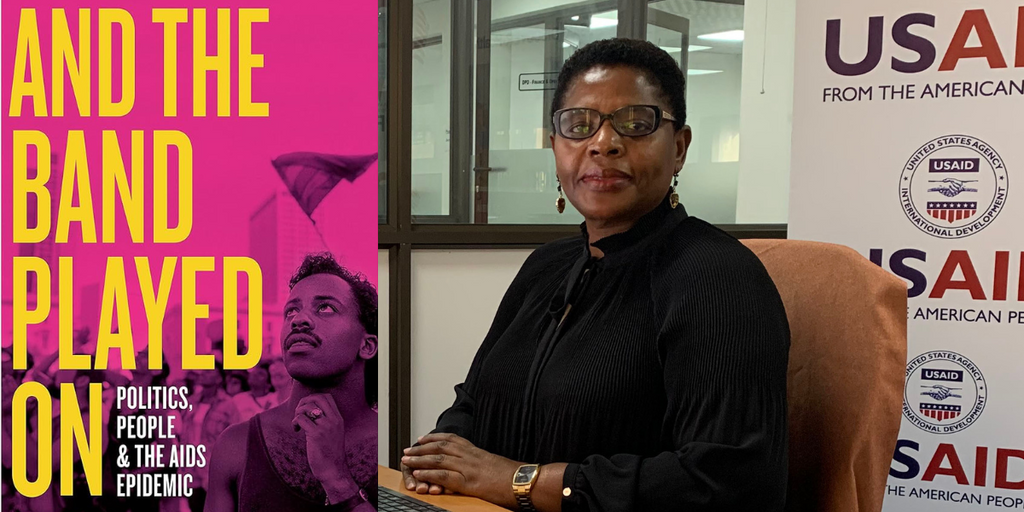
Muka Chikuba-McLeod (SPH’98), a co-recipient of SPH’s 2023 Distinguished Alumni Award , is a Zambian physician and the executive vice president of international programs at the global health consulting organization John Snow, Inc. (JSI). Following medical school, Chikuba-McLeod worked on the frontlines of Zambia’s HIV crisis for seven years. The experience drove her to pursue a career in public health, where she felt she could make an impact on a larger scale. When asked what one piece of public health content she would recommend to the SPH community, Chikuba-McLeod says, “I think it has to be And the Band Played On .”
The 1993 film, based on American journalist Randy Shilts’s 1987 book by the same name, tells a story not unlike Chikuba-McLeod’s own, following an epidemiologist who worked on an Ebola outbreak in Zaire in the late 1970s and later studied HIV/AIDS at the Centers for Disease Control and Prevention in the early 1980s. “I’m also an epidemiologist—apart from having an MPH in international health, I have a master of science in epidemiology,” says Chikuba-McLeod, who was responsible for organizing HIV treatment for over 300,000 Zambians in her last role at JSI. “And this movie was so heartbreaking, but also a realistic depiction of public health work as we do it, warts and all.”
Jirair Ratevosian / Sex Education

Jirair Ratevosian (SPH’07) also dedicated a large chunk of his career to HIV/AIDS work. In his most recent role as the first ever health equity advisor in the US State Department, Ratevosian helped oversee the President’s Emergency Plan for AIDS Relief (PEPFAR) program. He then left the field to campaign for US representative of California’s 30 th Congressional District. Ratevosian, who is openly gay and married to Nigerian HIV activist Micheal Ighodaro , enthusiastically recommends the Netflix TV series Sex Education . He appreciates how the show raises awareness of sexual health in a way that destigmatizes coming out as LGBTQ+, which he says is an identity that personally took him many years to embrace.

Anoop Jain / “The Covenant of Water”
Anoop Jain , an assistant professor of environmental health, studies sanitation issues as social determinants of health in India. Trained in social epidemiology, Jain researches how access to clean water and toilets early in life affects health outcomes later in life. He is also the founding director of Sanitation and Health Rights in India , a nonprofit on a mission to end open defecation in the country.
Jain, who both conducts research in northern India and has family there, says he enjoys reading books by Indian and Indian-diaspora authors. He recently read Indian American physician and New York Times -bestselling author Abraham Verghese’s “ The Covenant of Water .” The novel, set in the coastal Indian state of Kerala, follows three generations of a family as they reckon with the drowning deaths of at least one person from each generation. Ultimately—without giving too much away—the matriarch connects the dots and uncovers the root cause of her family’s “curse,” says Jain.
“It is this interesting example of the ways in which epidemiology works,” he says. “It is this beautiful illustration of how people and their stories are data, and the ways in which it is incumbent on us, as public health researchers and scholars, to sift through that in order to seek out the truth.”
Jeneczka Roman / “A Primer on Power: Housing Justice and Health Equity” & Alexis Walls / Beacon Hill and 5

Alums Jeneczka Roman (SPH’20) and Alexis Walls (SPH’17) are colleagues at the Massachusetts Public Health Association (MPHA) where they collaborate to promote policies that support the health of Commonwealth residents. To stay abreast of the latest developments in local policy, Walls, an assistant campaign director at MPHA, listens to the New England Public Media podcast Beacon Hill and 5 . She says that while the podcast does not exclusively cover public health issues, it is a useful for keeping up broadly with what is happening in the Massachusetts State House, such as ongoing discussions on gun control. “It is five minutes and only comes out about once a week,” says Walls. “I think that is a great place for people to dig in.”
Roman, the assistant director of advocacy and communication at MPHA, says she returns time and time again to “ A Primer on Power: Housing Justice and Health Equity ,” a report published by the research organization Human Impact Partners. “I am not kidding when I say I refer to it almost weekly,” she says. “Oftentimes we get asked why a public health association is working on housing, and I think that this resource lays out beautifully the role public health practitioners can play in organizing in solidarity with movement groups to bring power back to community to advance housing and justice and how building power is so integral to advancing health equity and reducing negative health outcomes.”
Nickita Gupta / Health Pilots

Nickita Gupta is a current MPH student studying Community Assessment, Program Development, Implementation and Evaluation (CAPDIE) . During the summer of 2023, Gupta applied what she is learning to document the needs of Dorchester’s Grove Hall community during a practicum funded by the Activist Lab . In addition to her studies, Gupta also works as a part-time program coordinator for the nonprofit Center for Care Innovations (CCI), which aims to strengthen healthcare systems that provide care to historically underserved communities.
Gupta says she likes to listen to CCI’s podcast Health Pilots and would recommend it to others in the field. “All the topics are very pertinent to storytelling within public health practice,” she says. Some examples of topics covered in Health Pilots episodes include centering the resilience and wellness of care teams (“ Help the Helpers: Embracing the Cultural Shift for Trauma-Informed Care ”) and amplifying community voices in design projects (“ Centering Lived-Experience Experts as Equity Designers ”).
Dana Vasers / “Five Days at Memorial”

Dana Vasers , a former lawyer and a current MPH student studying healthcare management , also completed an Activist Practicum , using her skills as an attorney to support the Massachusetts Alcohol Policy Coalition.
Vasers recommends “ Five Days at Memorial ” by Sheri Fink. She says she read the book after completing an in-class activity in her Human Resource Management in Public Health course that referenced the events it chronicles. Set in New Orleans, Louisiana during the week following Hurricane Katrina, the book follows the staff of Memorial Medical Center (today, Ochsner Baptist Medical Center) as they grappled with how to care for their patients in the midst of severe flooding, a loss of power, and other challenging conditions.
MacKenzie Hilton / Coded Bias

MacKenzie Hilton (SPH ’24), who graduated with her MPH in December 2023, developed an interest in artificial intelligence (AI) and other emerging digital technologies while a student in the course Digital Disruption in Health: The Effects of Health Information Technologies on Polices, Delivery, Patient Engagement, And Health Outcomes taught by Michelle Sasso . Hilton proceeded to go down a rabbit hole, watching a variety of shows about AI on Netflix.
Hilton recommends the 2020 documentary Coded Bias . She found that the film, which investigates racial bias in facial recognition algorithms, provided her with a useful framework for thinking about the challenges of implementing digital tools in a way that reduces rather than exacerbates health inequities. Hilton went on to find a practicum position at Boston Children’s Hospital that allowed her to explore the topic further and even gave her the opportunity to help outline guiding principles for the equitable development and application of AI in healthcare. She says that she recommended Sasso’s course to all her friends, telling them, “You’re going to love it!”
Explore Related Topics:
- school news
- Share this story
- 0 Comments Add
Writer/Editor, School News

Megan Jones is the writer and editor focusing on school news at the School of Public Health. Profile
Comments & Discussion
Boston University moderates comments to facilitate an informed, substantive, civil conversation. Abusive, profane, self-promotional, misleading, incoherent or off-topic comments will be rejected. Moderators are staffed during regular business hours (EST) and can only accept comments written in English. Statistics or facts must include a citation or a link to the citation.
Post a comment. Cancel reply
Your email address will not be published. Required fields are marked *

Call us @ 08069405205

Search Here

- An Introduction to the CSE Exam
- Personality Test
- Annual Calendar by UPSC-2024
- Common Myths about the Exam
- About Insights IAS
- Our Mission, Vision & Values
- Director's Desk
- Meet Our Team
- Our Branches
- Careers at Insights IAS
- Daily Current Affairs+PIB Summary
- Insights into Editorials
- Insta Revision Modules for Prelims
- Current Affairs Quiz
- Static Quiz
- Current Affairs RTM
- Insta-DART(CSAT)
- Insta 75 Days Revision Tests for Prelims 2024
- Secure (Mains Answer writing)
- Secure Synopsis
- Ethics Case Studies
- Insta Ethics
- Weekly Essay Challenge
- Insta Revision Modules-Mains
- Insta 75 Days Revision Tests for Mains
- Secure (Archive)
- Anthropology
- Law Optional
- Kannada Literature
- Public Administration
- English Literature
- Medical Science
- Mathematics
- Commerce & Accountancy
- Monthly Magazine: CURRENT AFFAIRS 30
- Content for Mains Enrichment (CME)
- InstaMaps: Important Places in News
- Weekly CA Magazine
- The PRIME Magazine
- Insta Revision Modules-Prelims
- Insta-DART(CSAT) Quiz
- Insta 75 days Revision Tests for Prelims 2022
- Insights SECURE(Mains Answer Writing)
- Interview Transcripts
- Previous Years' Question Papers-Prelims
- Answer Keys for Prelims PYQs
- Solve Prelims PYQs
- Previous Years' Question Papers-Mains
- UPSC CSE Syllabus
- Toppers from Insights IAS
- Testimonials
- Felicitation
- UPSC Results
- Indian Heritage & Culture
- Ancient Indian History
- Medieval Indian History
- Modern Indian History
- World History
- World Geography
- Indian Geography
- Indian Society
- Social Justice
- International Relations
- Agriculture
- Environment & Ecology
- Disaster Management
- Science & Technology
- Security Issues
- Ethics, Integrity and Aptitude

- Indian Heritage & Culture
- Enivornment & Ecology

EDITORIAL ANALYSIS The ART of India’s HIV/AIDS response
Source: The Hindu
■ Prelims: Current events of national importance, HIV, AIDS, WHO, Antiretroviral Therapy (ART), AZT (zidovudine), HAART, PLHIV etc
■ Mains GS Paper I & II: Development and management of social sectors/services related to Health and education etc
ARTICLE HIGHLIGHTS
- On April 1, 2004, t he Indian government had launched Free Antiretroviral Therapy (ART), for Persons living with HIV (PLHIV).
INSIGHTS ON THE ISSUE

- HIV attacks CD4, a type of White Blood Cell (T cells) in the body’s immune system. T cells are those cells that move around the body detecting anomalies and infections in cells.
- Once this virus enters the body, it can never be removed.
- In a healthy body, CD4 count is between 500- 1600, but in an infected body, it can go as low as 200.
- It becomes difficult for a person infected with this virus to recover from even a minor injury or sickness.
Anti-retro vial Therapy(ART):
- It is a combination of daily medications that stop the virus from reproducing .
- The therapy helps in protecting CD4 cells, keeping the immune system strong enough to fight off the disease.
- It helps in stopping its progression to AIDS ( a spectrum of conditions caused by infection due to HIV).
- The first antiretroviral drug, AZT (zidovudine), was approved by the US Food and Drug Administration (US FDA) in March 1987.
The evolution to ART:
● the un general assembly’s millennium summit(2000): it issued the declaration to stop and reverse the spread of hiv., ● the global fund to fight aids, tuberculosis and malaria was created in 2002 which advocated universal access to hiv prevention, treatment, care and support services., ● in 2004, the number of plhiv in india was estimated to be 5.1 million, with a population prevalence of 0.4%., ● the ‘cocktail therapy’ or haart (highly active antiretroviral therapy), became available starting in 1996, but costs were prohibitively high..
- In 2006, the free ART was made available for children as well.
Impact of free ART:
- 1,264 Link ART centers are providing free ART drugs to approximately 8 million PLHIV on treatment.
- The prevalence of HIV in 15-49 years has come down to 20 ( confidence interval 0.17%-0.25%)
- The burden of disease in terms of estimated PLHIV has been coming down to 4 million.
- India’s share in PLHIV globally had come down to 3% (from around 10% two decades ago).
- The annual new HIV infections in India have declined by 48% against the global average of 31% (t he baseline year of 2010).
- The annual AIDS-related mortalities have declined by 82% against the global average of 47% ( the baseline year of 2010).
- Dolutegravir (DTG), a new drug with superior virological efficacy and minimal adverse effects was introduced in 2020.
- In 2021, India adopted a policy of rapid ART initiation in which a person was started on ART within seven days of HIV diagnosis, and in some cases, even the same day.
Other initiatives which have contributed to halting the HIV epidemic:
- Provision of free di agnostic facilities
- Attention on prevention of parent to child transmission of HIV (PPTCT) services
- Prevention, diagnosis and management of opportunistic infections including management of co-infections such as tuberculosis (TB).
Treat All’ approach(2017) :
- It ensures that ART is initiated, irrespective of CD4 count.
- It has contributed to reduced virus transmission, both at the individual and the community levels.
- It is supplemented by free of cost v iral load testing for all PLHIV on treatment.
- which minimizes the number of patient visits to the ART centers, reducing travel time and costs for the patients.
- It increases adherence to treatment besides decongesting ART centers by reducing the average daily OPD, giving health-care workers more time to attend to other patients.
Recent steps:
- reduce AIDS-related mortalities by 80%
- eliminate vertical transmission of HIV and syphilis .
- 95% of all people l iving with HIV know their HIV status
- 95% of all people diagnosed with HIV infection receive sustained antiretroviral therapy (ART)
- 95% of all people r eceiving antiretroviral therapy achieve viral suppression by 2025 .
Challenges :
- The delayed enrolment to the ART facilities: In India, patients presenting with CD4 count <200 to ART centers constitute almost a third of total foot fall.
- Then they start missing doses and miss medicines for months or completely drop out.
- This results in the development of resistance as well.
- This ‘loss to follow up’ needs to be addressed.
What steps need to be taken?
- The sustained supply and availability of ART needs to be ensured by the national programme, i n every geography of the country and more so for tough terrain, hilly and remote areas.
- There is a need to focus on the private sector engagement in care of PLHIV.
- There is a need for constant training and capacity building of staff as science keeps evolving and should be focused more on hands-on training.
- PLHIV are living normal bu t have other health conditions that need to be addressed.
- A focused approach needs to be adopted t o reduce preventable mortality that includes systematic death reviews and availability of advanced diagnostics.
Reasons for success of free ART:
- Political will and constant support of successive governments
- sustained and sufficient funding, regular programme reviews and field-based monitoring, a series of complementary initiatives
- Community and stakeholder engagements and participation
- People-centric modifications in the service delivery
- Bridging the policy intentions to implementation gaps, and continuous expansion of services to cover more people living with HIV.
Way Forward
- The free ART initiative paved the path for bending the HIV/AIDS epidemic curve in India.
- The 20 years of free ART and subsequent steps under the NACP have the potential to guide other public health programmes in the country.
- The learnings can and should be used to launch a nationwide free hepatitis C treatment initiative in India and accelerate progress towards hepatitis C elimination.
QUESTION FOR PRACTICE
Besides being a moral imperative of the Welfare State, primary health structure is a necessary precondition for sustainable development.” Analyze.(UPSC 2021) (200 WORDS, 10 MARKS)

- Our Mission, Vision & Values
- Director’s Desk
- Commerce & Accountancy
- Previous Years’ Question Papers-Prelims
- Previous Years’ Question Papers-Mains
- Environment & Ecology
- Science & Technology
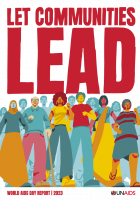
- About UNAIDS
- Global AIDS Strategy 2021-2026
- United Nations declarations and goals
- UNAIDS governance
- UNAIDS Programme Coordinating Board
- Results and transparency portal
- UNAIDS Cosponsors
- UNAIDS ambassadors and global advocates
- UNAIDS leadership
- UNAIDS evaluation office
- UNAIDS ethics office
- UNAIDS transformation
- Community pandemic response
- Education Plus Initiative
- Global alliance to end AIDS in children
- Equal access to cutting edge HIV technologies
- Save lives: Decriminalize
- Global council on inequality, AIDS and pandemics
- Resources and financing
- War in Ukraine
- Global HIV Prevention Coalition
- Global Partnership to Eliminate Stigma and Discrimination
- COVID-19 and HIV
- 2025 AIDS targets
- AIDS and SDGs
- Community mobilization
- Fast-Track cities
- H6 partnership
- HIV prevention
- HIV treatment
- Human rights
- Key populations
- Private sector and the AIDS response
- Security and humanitarian affairs
- Social protection
- Universal health coverage
- Young people
- Press centre
- Publications
- Infographics
- FAQ on HIV and AIDS
- World AIDS Day
- Zero Discrimination Day
- Latest data on HIV
- Data on key populations
- Laws and policies
- HIV financial resources
- Technical Support Mechanism
- Learn about HIV and AIDS
- Take action
- Become a donor
- Investment Book
Press release and statement archive
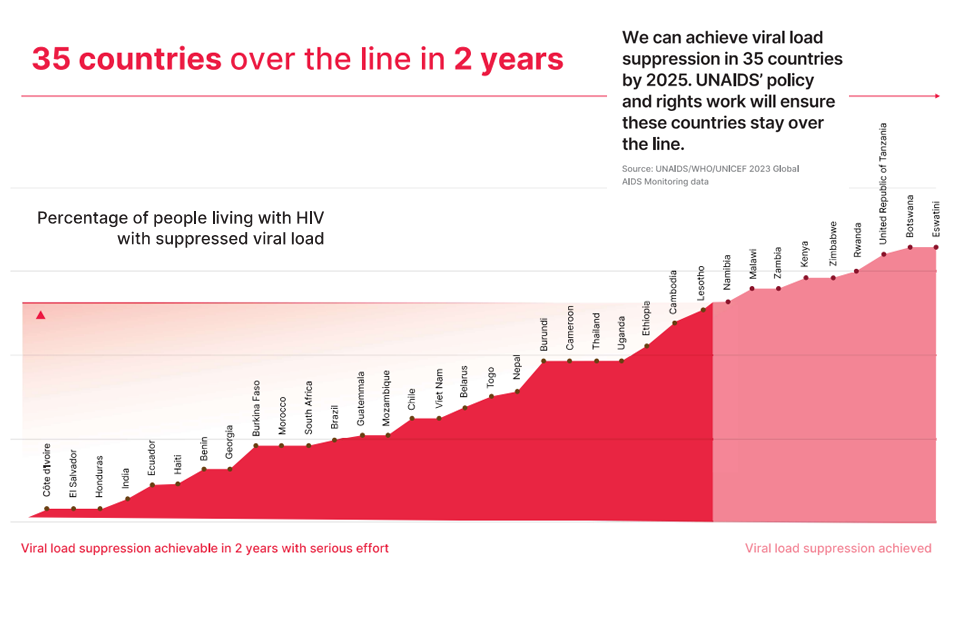
With a modest increase in investment UNAIDS can get 35 countries over the line to end their AIDS pandemics by 2025
UNAIDS is urging donors for a modest increase in funding to ensure that 35 countries can end their AIDS pandemics by 2025, five years ahead of the 2030 target. Current funding for UNAIDS is at US$ 160 million, less than 50% than the resources available in 2015. For maximum impact UNAIDS estimates it will need US$ 210 million annually which represents less than 0.02% of total health spending in low- and middle-income countries.
28 March 2024 | Email this link to me |
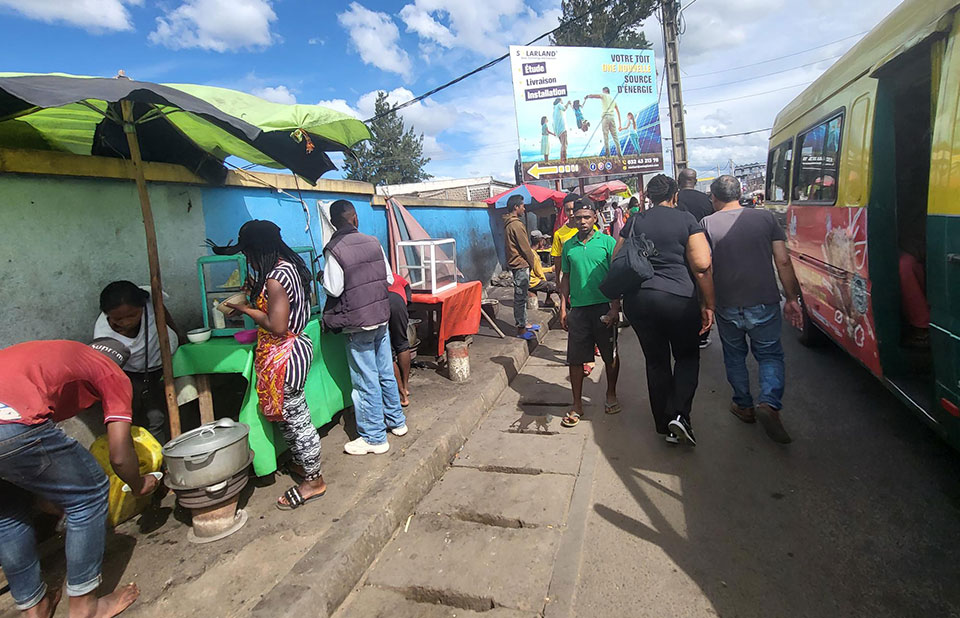
UNAIDS urges Indian Ocean Island countries to strengthen HIV prevention to end AIDS
Despite progress across most of sub-Saharan Africa, UNAIDS warns that gaps in HIV prevention are driving new HIV infections in the Indian Ocean Countries (IOC) and several other countries in Africa. The critical gaps in HIV prevention were the focus of a workshop organized by UNAIDS and UNFPA which was hosted in Madagascar between 18 and 20 March to address some of the barriers to accelerating progress.
27 March 2024 | Email this link to me |

UNAIDS welcomes governments’ commitment to end AIDS, tackle gender-based violence, discrimination and inequalities
On 22 March, governments attending the 68 th session of the Commission on the Status of Women (CSW) adopted, by consensus, a resolution focused on advancing the rights and empowerment of women and girls as part of efforts to end AIDS.
25 March 2024 | Email this link to me |
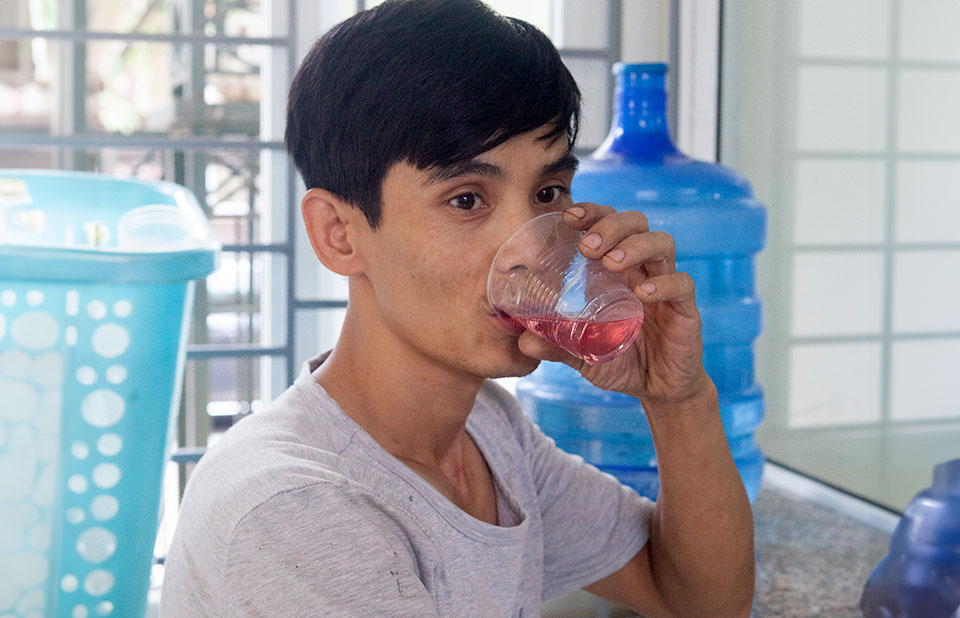
UNAIDS welcomes the adoption of a crucial resolution recognizing harm reduction measures at the UN Commission on Narcotic Drugs
UNAIDS welcomes the adoption of a key resolution today at the 67th session of the United Nations Commission on Narcotic Drugs (CND), recognizing harm reduction for the first time as an important part of an effective public health response. The resolution encourages member states to develop and implement harm reduction measures to minimize the adverse public health and social consequences of the non-medical use of illicit drugs. UNAIDS congratulates the CND and the CND Chair for this historic milestone.
22 March 2024 | Email this link to me |
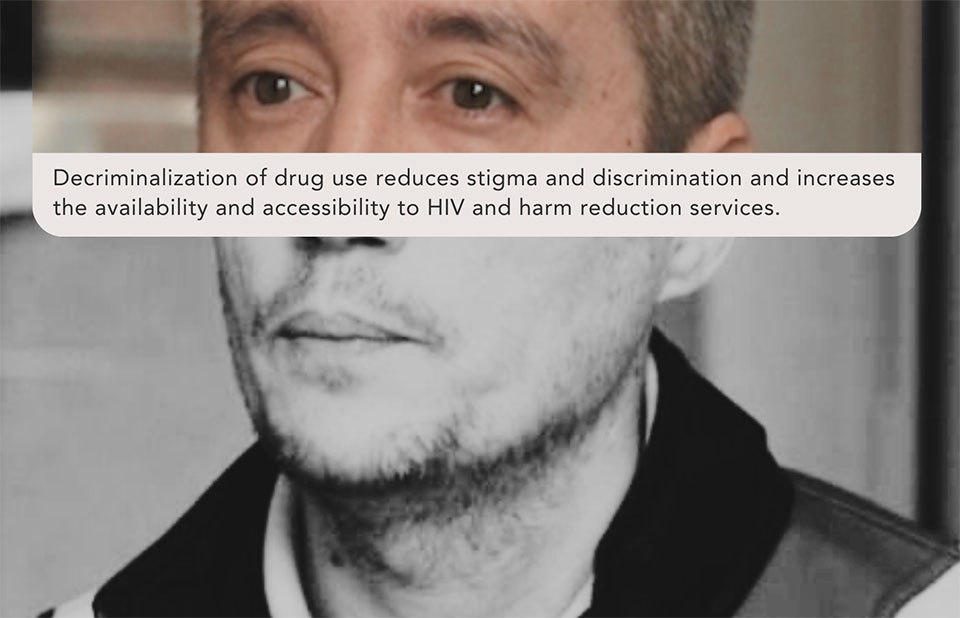
UNAIDS urges scaling up of evidence-based services to address the transmission of HIV and viral hepatitis among people who use drugs
At the 67th meeting of the United Nations Commission on Narcotic Drugs taking place in Vienna, UNAIDS has called for the urgent scaling up of services to prevent new HIV and viral hepatitis infections among people who use drugs. Addressing delegates in her video message, UNAIDS Executive Director, Winnie Byanyima, commended some countries for making progress in implementing evidence-based programmes but called for bolder action.
14 March 2024 | Email this link to me |

Reductions in new HIV infections in several Global HIV Prevention Coalition countries, but global progress needs to be accelerated
A new report, HIV Prevention: From Crisis to Opportunity shows that HIV infections continue to decline in countries that are part of the Global HIV Prevention Coalition (GPC) faster than in the rest of the world.
13 March 2024 | Email this link to me |
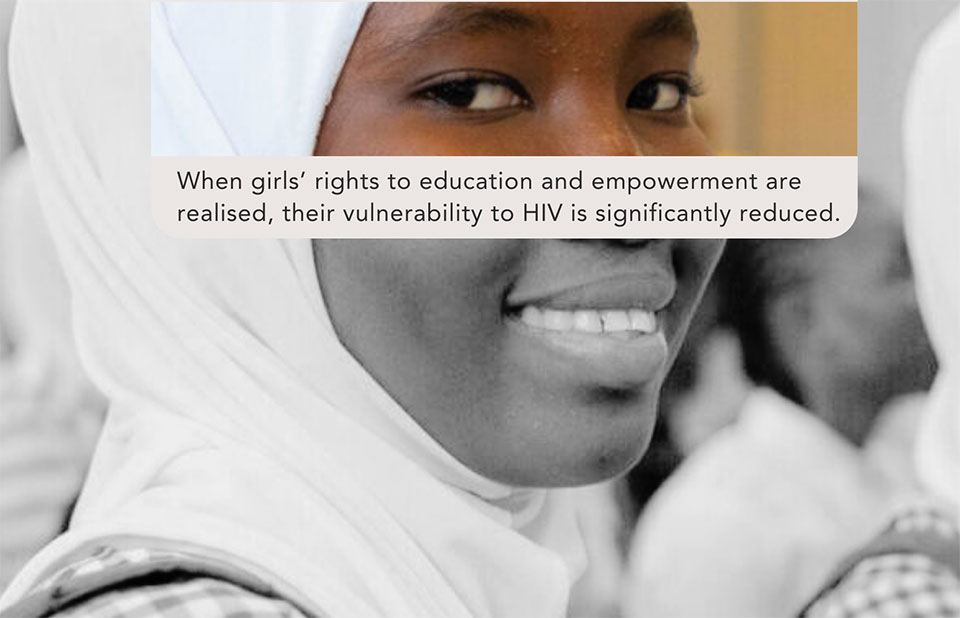
At the 68th Commission on Status of Women UNAIDS calls for action to achieve gender equality and end AIDS
UNAIDS is gearing up for the 68th session of the Commission on the Status of Women (#CSW68) which begins today and will run until 22 March 2024. #CSW68, the United Nations largest annual gathering on gender equality and women’s empowerment, is being held this year under the priority theme, Accelerating the achievement of gender equality and the empowerment of all women and girls by addressing poverty and strengthening institutions and financing with a gender perspective.
11 March 2024 | Email this link to me |

On International Women’s Day, UNAIDS calls for protecting women’s rights to protect their health
Ahead of International Women’s Day, celebrated on 8 March, UNAIDS is calling for the protection of women’s rights to protect their health.
06 March 2024 | Email this link to me |
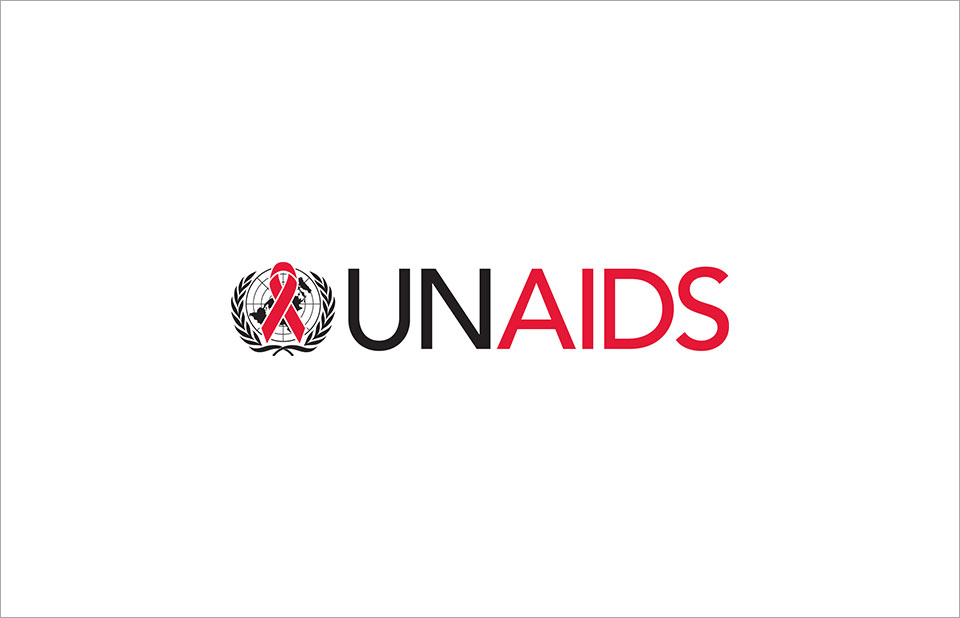
UNAIDS Executive Director Winnie Byanyima responds to the passage of the Human Sexual Rights and Ghanaian Family Values Bill in Ghana’s parliament
Responding to the passage of the Human Sexual Rights and Ghanaian Family Values Bill in Ghana’s parliament, UNAIDS Executive Director Winnie Byanyima said:
28 February 2024 | Email this link to me |

Expertise France partners with UNAIDS to fight HIV stigma and discrimination in western and central Africa
The French public international cooperation agency ‘Expertise France’ and UNAIDS have signed a new partnership agreement to fight stigma and discrimination in six western and central African countries.
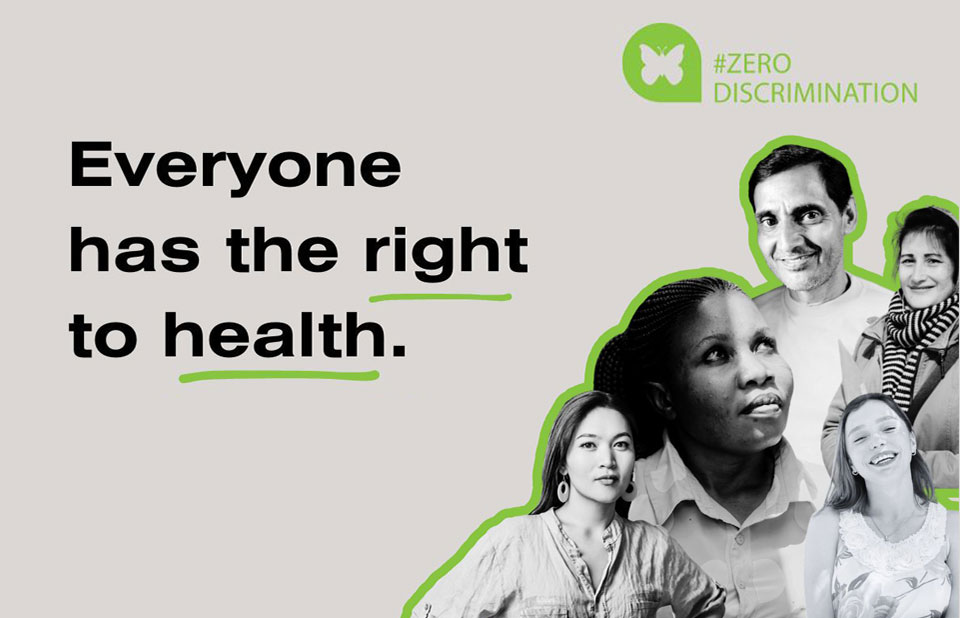
On the 10th anniversary of Zero Discrimination Day UNAIDS calls for the protection of human rights as a path to protecting health for all
On this Zero Discrimination Day (1 March), and across the whole month of March, events and activities will remind the world of this vital lesson and call to action: by protecting everyone’s health, we can protect everyone’s rights.
27 February 2024 | Email this link to me |

Member States negotiating the pandemic instrument have an opportunity to save lives and keep the world safe, says UNAIDS
As Member States enter the next stage of drafting and negotiating a new Pandemics Prevention, Preparedness and Response Accord, and the targeted revision of the International Health Regulations (IHR), UNAIDS underscores the importance of protecting the gains made in the AIDS response and encourages Member states to use that experience to help prevent and respond to future pandemics and health emergencies.
18 February 2024 | Email this link to me |
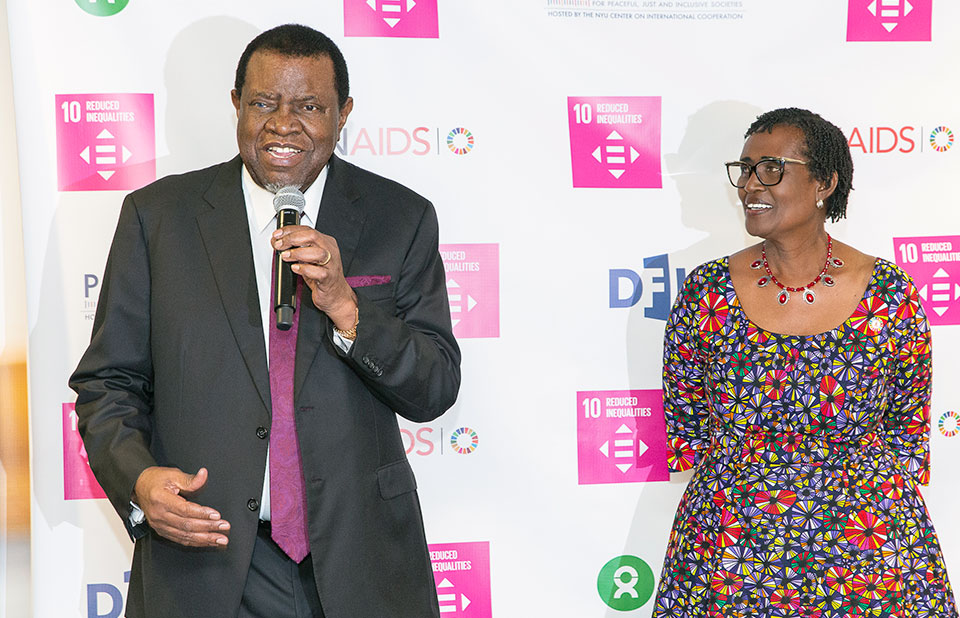
UNAIDS mourns the passing of Hage Geingob, President of Namibia
It is with profound sadness that UNAIDS learns of the passing of Dr Hage G. Geingob, President of the Republic of Namibia. President Geingob was a distinguished leader, a tireless advocate for social justice, and a steadfast supporter of efforts to end AIDS.
05 February 2024 | Email this link to me |

UNAIDS Executive Director: let women and girls lead to protect and advance human rights globally
At a conference hosted in Oslo by the Norwegian Agency for Development Cooperation (Norad), UNAIDS Executive Director, Winnie Byanyima, has made an impassioned call to all international partners to support women and girls from marginalized communities at the frontlines of the defence of human rights. Only by ensuring that the rights of everyone are protected can the world ensure that the health of everyone is protected, and that the Sustainable Development Goals are achieved.
01 February 2024 | Email this link to me |

UNAIDS welcomes Jamaica’s expansion of protections against gender-based violence
UNAIDS welcomes Jamaica’s expansion of protections against gender-based violence as the Domestic Violence (Amendment) Act comes into effect on 22 January 2024.
22 January 2024 | Email this link to me |
An official website of the United States government
The .gov means it's official. Federal government websites often end in .gov or .mil. Before sharing sensitive information, make sure you're on a federal government site.
The site is secure. The https:// ensures that you are connecting to the official website and that any information you provide is encrypted and transmitted securely.
- Publications
- Account settings
- Browse Titles
NCBI Bookshelf. A service of the National Library of Medicine, National Institutes of Health.
Institute of Medicine (US) Committee to Study HIV Transmission Through Blood and Blood Products; Leveton LB, Sox HC Jr., Stoto MA, editors. HIV And The Blood Supply: An Analysis Of Crisis Decisionmaking. Washington (DC): National Academies Press (US); 1995.

HIV And The Blood Supply: An Analysis Of Crisis Decisionmaking.
- Hardcopy Version at National Academies Press
8 Conclusions and Recommendations
The HIV epidemic has taught scientists, clinicians, public health officials, and the public that new infectious agents can still emerge. The nation must be prepared to deal with a fatal illness whose cause is initially unknown but whose epidemiology suggests it is an infectious disease. The AIDS epidemic has also taught us another powerful and tragic lesson: that the nation's blood supply—because it is derived from humans—is highly vulnerable to contamination with an infectious agent. A nation's blood supply is a unique, essential, life-giving resource. Whole blood and many blood products are lifesaving for many people. As a whole, our nation's system works effectively to supply the nation with necessary blood and blood products and its quality control mechanisms check most human safety threats. The events of the early 1980s, however, revealed an important weakness in the system—in its ability to deal with a new threat that was characterized by substantial uncertainty. The potential for recurring threats to the blood supply led this Committee to reappraise the processes, policies, and resources through which our society attempts to preserve its supply of safe blood and blood products.
- General Conclusions
The events and decisions that the Committee has analyzed underscore the difficulty of decisionmaking when the stakes are high, when decisionmakers may have personal or institutional biases, and when knowledge is imprecise and incomplete. The Committee attempted to understand the complexities of the decisionmaking process during the period analyzed in this report and develop lessons to protect the blood supply in the future. In retrospect, the system was not dealing well with contemporaneous blood safety issues such as hepatitis, and was not prepared to deal with the far greater challenge of AIDS .
By January 1983, the Centers for Disease Control (CDC) had accumulated enough epidemiological evidence to conclude that the agent causing AIDS was almost certainly transmitted through blood and blood products and could be sexually transmitted to sexual partners. The conclusion that the AIDS agent was blood-borne rested on two findings. First, AIDS was occurring in transfusion recipients and individuals with hemophilia who had received AHF concentrate; these AIDS patients did not belong to any other known high-risk group for contracting AIDS. Second, the epidemiologic pattern of AIDS was similar to hepatitis B, another blood-borne disease. However, the magnitude and consequences of the risk for transfusion and blood product recipients was not known at this time. Furthermore, the epidemiological pattern of the new disease was difficult to interpret because, unlike most infectious diseases, there seemed to be several years between exposure leading to infection and the development of symptoms. As a result, physicians and public health officials underestimated the large number of infectious people who had no symptoms of AIDS but could transmit the disease to others and therefore substantially understated the risk of infection.
Compared to the pace of many regulatory and public health decision processes, the federal government responded relatively swiftly to the early warnings that AIDS might be transmitted through blood and blood products. Public and private sector officials considered a range of clinical and public health interventions for reducing the risk of AIDS transmission through blood and blood products. This period, however, was characterized by a great deal of scientific uncertainty about the risks of HIV infection through blood and blood products and about the costs and benefits of the available options. The result, the Committee found, was a pattern of responses which, while not in conflict with the available scientific information, was very cautious and exposed the decisionmakers and their organizations to a minimum of criticism. This limited response can be seen in the refusal of blood banks in 1983 and 1984 to screen for and defer homosexuals or use surrogate tests ( Chapter 5 ), in the Food and Drug Administration's (FDA) cautious and inadequate regulatory approach to the recall of potentially contaminated AHF concentrate ( Chapter 6 ), and in the failure of physicians and the National Hemophilia Foundation to disclose completely the risks of using AHF concentrate and the alternatives to its use ( Chapter 7 ).
Blood safety is a shared responsibility of many diverse organizations. They include U.S. Public Health Service agencies such as the CDC, the FDA, and the National Institutes of Health (NIH), and private-sector organizations such as community blood banks and the American Red Cross, blood and plasma collection agencies, blood product manufacturers, groups such as the National Hemophilia Foundation (NHF), and others. The problems the Committee found were inadequate leadership and inadequate institutional decisionmaking processes in 1983 and 1984. No person or agency was able to coordinate all of the organizations sharing the public health responsibility for achieving a safe blood supply.
Decisionmaking Under Uncertainty
The management of a public health risk requires an evolving process of decisionmaking under uncertainty. It includes interpretive judgment in the presence of scientific uncertainty and disagreement about values. Public health officials must characterize and estimate the magnitude of the risk, which involves considering both the likelihood that infection might occur in various circumstances, and the costs and benefits associated with each of the possible uncertain outcomes. They must also develop and test public health and clinical care strategies, and communicate with the public about the risk and strategies for reducing it. When confronted with a poorly understood and anomalous public health threat, inertia often influences decisions. It is often easier to maintain the status quo than to make a change. In fact, regulatory policymakers, health scientists, and medical experts often require substantial scientific evidence before informing the public and adopting remedial action. Lack of scientific consensus becomes a kind of amplifier for the usual discord and conflict that can be expected whenever an important science-based public policy decision—one profoundly affecting lives and economic interests—must be made. First, uncertainty creates opportunities for advocates of self-interested and ideological viewpoints to advance plausible arguments that favor their desired outcome. Second, uncertainty intensifies bureaucrat cautiousness.
In the course of its investigations, the Committee learned several lessons about decisionmaking under uncertainty. These are set out here both as general lessons and to provide a framework for the recommendations that follow.
Risk Perception
Risk perception is shaped by social tensions, and cultural, political, and economic biases (Douglas 1985). It is important to understand the different contexts in which risk is perceived and the complex system of beliefs, values, and ideals that shape risk perception (Nelkin 1989). There are several other factors that influence risk perception, including locus of control, the type of risk posed by the threat, and the time interval involved in evaluating the risk. For example, people tend to underestimate risks that they perceive to be under their control, risks associated with a familiar situation, and low probability events (Douglas 1985). People have difficulty accepting estimates of a risk that is involuntary, uncertain, unfamiliar, and potentially catastrophic (Fischoff 1987). The epidemic caused by HIV in the blood supply illustrates these patterns of perception and behavior with respect to risk.
Risk Assessment Versus Risk Management
A central precept of risk management is to separate the assessment of risk from the management of its consequences (NRC 1983). Otherwise, risk managers tend to bias their estimates of the magnitude of the risk in favor of their preconceived notions about appropriate or desirable policy choices. The events that the Committee studied provide examples of what can happen when this precept is not followed. When there is uncertainty, it may be necessary to assess risk by making subjective estimates rather than by obtaining objective measures. Such was the case in 1983 when, as part of implicit risk-benefit calculations about donor screening and deferral, blood banks and blood product manufacturers had to make judgments about the risk that their products could transmit AIDS (see Chapter 5 ). Anticipating the consequences of taking action, which is in the domain of risk management, may bias risk estimates toward values that support risk-averse action. When blood bank officials estimated the risk of transmitting AIDS as ''one per million" transfusions, they chose a rate that was low enough to justify their reluctance to take further action. Despite mounting evidence that the risk was much higher, they maintained their original estimate throughout 1983. If the CDC had made numeric estimates of the risk, and the blood banks, blood product manufacturers, or the FDA had used these estimates in a formal analysis of the decision problem, they might have reached different conclusions about, for example, surrogate testing for AIDS.
Consider the Full Range of Possibilities
When there is uncertainty about the facts that will determine the consequences of a decision, a systematic approach is usually best (NRC 1994). One important principle is to consider the full range of assumptions and alternative actions, not only worst-case scenarios. In the events studied by the Committee, systematic denial of worst-case scenarios was a recurring theme, as can be seen in the way that the NHF and the FDA discussed the CDC's warnings in 1982 and early 1983. The plasma fractionators introduced a worst case scenario of their own at the July 1983 Blood Products Advisory Committee (BPAC) meeting, when they estimated that three or four suspect donors and an automatic recall policy could lead to recall of all of the nation's supply of AHF concentrate ( Chapter 6 ). A closely related principle is to scrutinize the evidence to ascertain what is based on fact, what is a "best-guess" estimate, and what is simply untested conventional wisdom.
One approach to such an analysis would be to use a formal group process to systematically sample expert opinion on relevant factors such as the probability of infection and the economic and noneconomic costs and benefits of each of the possible outcomes. Often these officials should use decision analysis, which takes into account the likelihood of events and the magnitude of their outcomes, as a tool to compare the expected value of the outcome of the policy alternatives under consideration. Two somewhat analogous models to consider include those used in Institute of Medicine studies to establish priorities for the development of new vaccines (IOM 1985) and to evaluate the artificial heart program of the National Heart, Lung, and Blood Institute (IOM 1991). The book Acceptable Risk (Fischoff, et al. 1981) also offers sensible approaches to dealing with this kind of situation.
Risk Reduction Versus Zero Risk
Decisionmakers tend to seek zero-risk solutions even when they are unattainable or unrealistically costly (NRC 1994). In doing so, they may run the risk of failing to implement solutions that are less effective but are certain to reduce illness. The failure to adopt risk-reduction strategies can be seen in the resistance of blood banks to screening for homosexual activity or using surrogate tests for AIDS ( Chapter 5 ) and in FDA's limited approach to product recall decisions ( Chapter 6 ). Chapter 7 also points out that many risk-reduction strategies for individuals with hemophilia were available but not fully disclosed or recommended. The perfect should not be the enemy of the good.
Risk Communication
Risk communication is a sensitive area because of its influence on the perceptions and behaviors of health professionals and consumers, regulatory policies, and public decisionmaking (Nelkin 1989). Many public health officials and physicians wish to appear in command and infallible. When uncertain, they remain silent rather than disclose their ambivalence (NRC 1989). In the Committee's view, however, the greater the uncertainty, the greater the need for communication. The Committee's analysis of physician–patient communications at the beginning of the AIDS era illustrates the tragedies that can accompany silence about risks ( Chapter 7 ). Risk-communication skills are equally important when presenting information to the general public. The blood banks' reluctance to acknowledge the risk of transfusion-associated AIDS ( Chapter 5 ) seems to have been due in part to the difficulties that they foresaw in presenting this information to potential donors and recipients.
Other important principles of risk communication are that the source of the information must be credible, the process should be open and two-way, and the message should be balanced and accurate (NRC 1989). When there was no other sources of information for physicians treating people with hemophilia and for their patients, the NHF and its Medical and Scientific Advisory Council (MASAC) took on an important risk-communication role—providing what would now be called "clinical practice guidelines." The NHF's credibility in this area was eventually seriously compromised by its financial connections to the plasma fractionation industry.
Bureaucratic Management of Potential Crises
Federal agencies had the primary responsibility for dealing with the national emergency posed by the AIDS epidemic. The Committee scrutinized bureaucratic function closely, and came to the following conclusions about the management of potential crises.
Coordination and Leadership
A crisis calls for extraordinary leadership. Legal and competitive concerns may inhibit effective action by agencies of the federal government. Similarly, when policymaking occurs against a backdrop of a great deal of scientific uncertainty, bureaucratic standard operating procedures designed for routine circumstances seem to take over unless there is a clear-cut decisionmaking hierarchy. An effective leader will insist upon coordinated planning and execution. Focusing efforts and responsibilities, setting timetables and agendas, and assuming accountability for expeditious action cannot be left to ordinary standard operating procedures. These actions are the responsibilities of the highest levels of the public health establishment.
The Public Health Service failed to bring these leadership functions to bear when CDC scientists raised concerns about the blood supply at the January 4, 1983 meeting but received no public support from the director of the CDC or the office of the Assistant Secretary for Health. Similarly, the record does not indicate that the highest levels of the FDA or the PHS were involved in responding to advice from the BPAC regarding donor deferral or product recall. Part of this leadership problem may stem from major changes in the PHS leadership that took place during this period: the leadership of the FDA, the CDC, and the NIH, and the person serving as the Assistant Secretary for Health all changed between 1982 and 1984.
Advisory Mechanisms
In the early 1980s, the FDA and other agencies did not have a systematic approach to conducting advisory committee proceedings. Such an approach requires that agencies tell their advisory committees what is expected of them, keep attention focused on high-priority topics, and independently evaluate the advice offered. No regulatory process should have its information base effectively controlled by an advisory panel. Public agencies must be able to generate and analyze the information that they need to assure that decisions serve the needs of the public. The FDA failed to observe this principle when it allowed statements and recommendations of the BPAC to go unchallenged, apparently because it could not independently analyze the information ( Chapter 6 ).
Because mistakes will always be made and opportunities sometimes missed, regulatory structures must be organized and managed to assure both the reality and the continuous appearance of propriety. The prominence of representatives from blood banks and blood product manufacturers on the BPAC, with no balancing influence from consumers and no process within the FDA to evaluate its recommendations ( Chapter 6 ), is a failure of advisory committee management. Perhaps advisory committees should contain fewer topical experts and more members with expertise in principles of good decisionmaking and the evaluation of evidence. A committee so constituted might run a reduced risk of standing accused of having conflicts of interest.
Analytic Capability and Long-Range Vision
Leadership passes to the organization that has access to information and the ability to analyze it. Federal agencies should avoid exclusive reliance upon the entities which they regulate for analysis of data and modeling of decision problems. The FDA should have had some independent capacity to analyze the information presented at the July 1983 BPAC meeting that suggested that with only three or four suspect donors, an automatic recall policy would completely deplete the nation's supply of AHF concentrate ( Chapter 6 ). In addition, there did not seem to be any focus within the Public Health Service prepared to, or charged to, analyze the options, costs, and benefits of the options for protecting the blood supply that were discussed at the January 4, 1983, meeting convened by CDC.
In addition, agencies need to monitor more systematically the long-term outcomes of blood transfusion and blood product infusion and to think far ahead to anticipate both new technologies and new threats to the safety of the blood supply. Because new pathogens can enter the blood supply and be propagated very rapidly through it, a low level of suspicion about a threat should trigger high-level consideration of how to manage and monitor the problem.
Through its fact-finding interviews and through written documents, the Committee found little evidence that the PHS agency heads and the Assistant Secretary for Health were involved in making decisions about protecting the blood supply in 1983 and 1984 when HIV was becoming increasing apparent as a threat. Most decisions and interagency communication seems to have occurred several levels below the top.
Presumptive Regulatory and Public Health Triggers
The Committee believes that the Public Health Service should prepare for future threats to the blood supply by specifying in advance the types of actions that should occur once the level of concern passes a threshold. In the face of scientific uncertainty, the PHS needs a series of criteria or triggers for taking regulatory or other public health actions to protect the safety of blood and blood products. The Committee favors a series of triggers in which the response is proportional to the magnitude of the risk and the quality of the information on which the risk estimate is based. Not all triggers should lead to drastic or irrevocable actions; some merely require careful consideration of the options or developing new information. This general principle is detailed by examples in each of the Committee's four areas of inquiry. Table 8.1 summarizes these triggers and corresponding actions.
Triggers for Taking Actions in Response to Uncertain.
Product Treatment
Whenever they propose new methods of protecting the safety of the blood supply, blood regulatory agencies must perform cost-utility or cost-benefit analyses to evaluate whether the intervention will advance the public health at reasonable costs. If manufacturers do not have market incentives, resources, or access to data to test promising methods, public agencies should create incentives or provide resources or access to data. In this case, the trigger is a new proposal to increase safety, and the action is for the public sector to assume responsibility for thorough analysis and development, or to create incentives for industry to do so.
When performing a cost-effectiveness analysis of new treatments for blood products, the potential to protect against other threats should always be a part of the analysis. Here, the trigger is the initiation of a cost-effectiveness analysis, and the action is to ensure that the analysis takes into account secondary benefits.
Donor Screening
Whenever epidemiologists identify a high-risk donor group, the FDA should immediately tell blood banks to create a way to defer that group and tell collection agencies to segregate and separately treat supplies obtained from those populations. Concerns about stigmatizing subpopulations and maintaining the supply of blood products should influence the means of taking actions, not whether to take action. In this case, the trigger to action is the identification of a high-risk population, and the action is deferral and segregation of lots.
Whenever any segment of the industry institutes a donor screening program, the FDA should require all segments of the industry to follow suit with actions that they believe will be at least as effective in promoting safety. Public regulators have a responsibility to monitor these efforts and to forge consensus or to impose the most effective methods as information concerning efficacy becomes available. Here, the trigger is one company's action to take an additional safety measure, and the response is for all companies to follow suit, or to be held accountable when they do not.
Blood banks should use a partially effective intervention that has little or no risk unless they can show that a better method will rapidly supersede it. In this case the trigger is the availability of an inherently risk-free, partially effective intervention, and the response to use that test/intervention unless it is certain to become redundant prior to realizing its full benefits.
When a test or treatment makes a product safer, manufacturers should withdraw all stocks of untested or untreated product as quickly as possible. Where immediate complete withdrawal might injure the public health, withdrawals should be partial or staged. Here, the trigger is the implementation of a new test or treatment process, and the action is to recall untested or untreated products as expeditiously as possible, given other considerations of public health.
A limited, staged, or selective recall places responsibility on public regulatory agencies to establish criteria for selecting lots for recall, to provide processes to permit effective implementation of the recall by industry, and to monitor the recall to assure that removal of the products occurs in the prescribed manner. In this case the trigger is the initiation of a recall action, and the response is to provide clear guidance and monitoring.
Communication to Patients and Providers
Whenever new information triggers inquiry into a possible threat to the blood supply, both patients and their physicians should have access to the information. Public officials should presume that candid statements and rigorous actions will enhance rather than erode public confidence and that persons using blood or blood products have the right to understand fully the risks and benefits of using these products. In this case, the trigger is new information relevant to the public health, and the action is to tell affected individuals what they need to make an informed choice: the facts, the gaps in knowledge, and the implications thereof.
- Recommendations
The Committee's charge was to learn from the events of the early 1980s the lessons that would help the nation prepare for future threats to the blood supply. The Committee identified potential problems with the system in place at that time (as summarized earlier in this chapter) and proposes changes that, if implemented in the early 1980s, might have moderated some of the effects of the AIDS epidemic on recipients of blood and blood products. This analysis has led the Committee to the following recommendations for Public Health Service agencies, for the blood and plasma fractionation industry, and for health care providers and the public. These recommendations address both public health options and individual clinical options.
The Committee is mindful of several caveats. First, the Committee is acutely aware of the difficulties of retrospective analysis, as described in Chapter 1 . Second, the Committee has not considered its recommendations from perspectives other than blood safety. Finally, the Committee tried to identify opportunities for institutional change that would respond to the problems that the Committee diagnosed. The Committee based its recommendations on the institutions as they functioned in the early 1980s, not as they exist now. The organizations responsible for blood safety and public health will have to evaluate their current policies and procedures to see if they fully address the issues raised by our recommendations.
The Public Health Service
Several federal agencies necessarily play important, often different roles in managing a public health crisis such as the contamination of blood and blood products by the AIDS virus. The National Blood Policy of 1973 charged the Public Health Service (including the CDC, the FDA, and the NIH) with responsibility for protecting the nation's blood supply.
The Committee has come to believe that a failure of leadership contributed to delay in taking effective action, at least during the period from 1982 to 1984. This failure led to incomplete donor screening policies, weak regulatory actions, and insufficient communication to patients about the risks of AIDS .
In the event of a threat to the blood supply, the PHS must, as in any public health crisis, insist upon coordinated action. The Secretary of Health and Human Services is responsible for all the agencies of the Public Health Service, 1 and therefore the Committee makes
Recommendation 1: The Secretary of Health and Human Services should designate a Blood Safety Director, at the level of a deputy assistant secretary or higher, to be responsible for the federal government's efforts to maintain the safety of the nation's blood supply.
Choosing a "lead person" is important because it is in the nature of federal agencies and their leaders to be at once competitive and protective. This condition is healthy in reasonable measure and in normal times. However, a serious threat to public health requires that agencies communicate, cooperate, and learn to view the world through each other's lenses. Once there is an action plan, the Secretary of Health and Human Services must hold the agency leaders accountable for enforcing cooperation in implementing the plan.
To be effective in coordinating the various agencies of the PHS, the Blood Safety Director should be at the level of a deputy assistant secretary or higher, and should not be a representative of any single PHS agency. When a threat does arise, the Blood Safety Director should create a crisis management team.
One such action was to establish, in July 1982, the Committee on Opportunistic Infections in Hemophiliacs (see Chapter 3 ). This group seems to have been organized by the CDC, but there is no record of its operations after August of that year.
Blood Safety Council
The AIDS crisis revealed that the institutions in place to ensure blood safety, both public and private, were unable to work cooperatively toward a common goal of a safe blood supply. The institutions were not accountable to anyone but themselves, and they failed to cooperate, to coordinate their activities, and to communicate effectively with physicians and the public. The Committee has become convinced that the nation needs a far more responsive and integrated process to detect, evaluate, and respond to emerging threats to the blood supply. To this end the Committee makes
Recommendation 2: The PHS should establish a Blood Safety Council to assess current and potential future threats to the blood supply, to propose strategies for overcoming these threats, to evaluate the response of the PHS to these proposals, and to monitor the implementation of these strategies. The Council should report to the Blood Safety Director (see Recommendation 1). The Council should also serve to alert scientists about the needs and opportunities for research to maximize the safety of blood and blood products. The Blood Safety Council should take the lead to ensure the education of public health officials, clinicians, and the public about the nature of threats to our nation's blood supply and the public health strategies for dealing with these threats.
Supplying safe blood and blood products to the nation—a public good—requires the cooperation of public and private institutions. The Blood Safety Council would give voice to the public's interest in having these institutions cooperate and would provide opportunities for them to do so.
The lessons of HIV transmission through blood and blood products show the need for an advisory council with a significantly greater level of diversity, responsibility, and authority than the current Blood Products Advisory Committee of the FDA. The BPAC is limited by the regulatory mission of the FDA which it advises, and there is no other body primarily concerned with blood safety as a whole. Representatives from governmental agencies, academia, the blood bank community, industry, and the public all have relevant expertise and perspectives and should be involved in the Blood Safety Council. A broad-based range of expertise in areas of hematology, infectious diseases, epidemiology, blood product manufacturing, blood collection and delivery, risk assessment, consumer advocacy, and cost-benefit analysis is essential.
The proposed Blood Safety Council would facilitate the timely transmission of information, assessment of risk, and initiation of appropriate action both during times of stability and during a crisis. The Council should report to the Blood Safety Director (see Recommendation 1). The Council would not replace the PHS agencies responsible for blood safety but would complement them by providing a forum for them to work together and with private organizations. The PHS agencies would be represented on the Council (see below and Figure 8.1 ). The Council would not have its own surveillance capability, but would work with CDC and FDA to interpret the information that those organizations can provide. It would not carry out or fund research itself, but would work with those at NIH and in the private sector to identify priorities for blood safety research. The Council would not have regulatory power, but would inform FDA actions from a blood safety rather than a product-specific perspective.
Figure 8.1.
Blood Safety Council relationships.
The organizations and groups that should be included in the Blood Safety Council, and the reasons for including them, are as follows:
- The FDA can provide a direct link between itself, the essential regulatory agency responsible for the safety of blood and blood products, and important sources of information, scientific support, and disease surveillance findings.
- The CDC can provide expertise in epidemiology, infectious diseases, and immunology as well as communicate the results of ongoing disease surveillance studies. The CDC's newly established emerging infectious disease program would also provide valuable information.
- The NIH can provide scientific expertise and the means to communicate information about essential research needs to the appropriate institutes for support of research.
- Representatives from academia can bring independent scientific and medical expertise, especially in hematology, infectious diseases, epidemiology, risk assessment, and cost-effectiveness analysis.
- Representatives from the volunteer blood collection community can bring experience with blood safety concerns and the knowledge of blood bank operations that is necessary to evaluate proposed change.
- Representatives from the private-sector blood product manufacturers and biotechnology companies can bring both experience with blood safety concerns and knowledge of plasma fractionation operations.
- Representatives of the general public (who may in the future require blood transfusions) and individuals who currently require frequent use of blood products, such as hemophilia patients, bring important perspectives on the trade-offs that must be considered in evaluating response options.
The Blood Safety Council should consider the following activities and issues:
Surveillance. Although the FDA and the CDC keep track of events in blood and blood product recipients, their surveillance systems are passive and incomplete. The Blood Safety Council should work with the CDC to design a system of active surveillance for adverse reactions in blood recipients, as described in Recommendation 5 below. If such a system is established, the Council would benefit from its results and should participate in its governance.
Expert Panel on Best Practices . Drawing on its members' knowledge about blood and blood product safety concerns, and about clinical alternatives, the Blood Safety Council could establish a panel of experts to provide the public and providers of care with information about risks and benefits, alternatives to using blood products, and recommended best practices, as described in more detail in Recommendation 13 below.
Investigate Methods to Make Blood Products Safer. The Council should evaluate new methods to make blood and blood products safer. One promising approach is double inactivation in the preparation of blood products, which minimizes the risk of transmission of infectious pathogens in the blood of the donor pool. At present, the FDA requires only a single inactivation process (usually solvent detergent or heat treatment) for most blood products manufactured in the United States. With the goal of maximizing the safety of the blood supply at minimal added cost, the Blood Safety Council should encourage the FDA to evaluate double inactivation methods and expeditiously relicense products manufactured by the improved technologies, if appropriate. The Blood Safety Council should also consider, at least yearly, in a public forum, opportunities to maximize the safety of the blood supply.
Another promising approach is to reconsider minimum pool size requirements in plasma product manufacturing. The FDA currently requires a large number of donors to be included in plasma pools used in the manufacture of plasma products in order to ensure a wide range of antibodies in preparations of intravenous gamma globulin. Pooling of plasma obtained from numerous donors, although permitting some economy of scale, also increases the risk that a large fraction of manufactured blood products will be contaminated by a single infected donor. The Blood Safety Council should consider this issue and address the safety and efficiency trade-offs in changing the minimum pool size.
The Blood Safety Council would provide information relevant to the decisions that individuals as well as public and private decisionmakers need to make. The forum would not have direct regulatory or other authority, but would function as a forum for holding the organizations with authority responsible for blood safety. In short, the Blood Safety Council could advocate the public's need for a responsible process for decisionmaking about public health policy. The following examples illustrate how regular public discussions of blood safety issues, in the presence of representatives from the relevant organizations' perspectives, could provide an opportunity to hold the organizations with authority accountable for blood safety.
If it had existed in the 1970s, for instance, the Blood Safety Council might have called for the development of heat-treated AHF concentrate to reduce the risk of hepatitis, which would have also reduced the risk of HIV transmission. It would have been able to do so if the NIH and blood products industry representatives on the Council had been called upon to make periodic reports to the Council during the 1970s about their efforts to deal with the hepatitis problem. These representatives would have fed the discussions of the Council back into their own organizations' decisionmaking.
In 1983, the Council could have provided a forum for CDC to present its concerns about HIV in the blood supply and held the FDA, the NHF, and the blood banks and fractionators accountable for responding constructively. CDC created a forum on its own by convening the January 4, 1983, meeting in Atlanta, but as the Committee's analysis indicates, the follow-up on this meeting was insufficient. If a standing Blood Safety Council had existed, the CDC scientists who had concerns about the safety of blood and blood products would have had an opportunity to hold blood collection organizations accountable for their decisions regarding donor deferral and surrogate testing. It would also provide an opportunity to hold plasma fractionators and the FDA accountable for its decisions with regard to heat-treated AHF.
Later that year, the Council could have provided a mechanism to evaluate the claims that automatic recall of AHF would have virtually eliminated the supply of AHF. As the analysis in Chapter 6 indicates, neither the BPAC nor the FDA staff had the capacity to analyze claims that a automatic recall would have such an effect. The Blood Safety Council could have insisted that the FDA commission a formal decision analysis of the options for surrogate testing, or the Council might have performed such an analysis itself. The FDA would retain its regulatory authority, and continue to get advice from the BPAC, but the Council would have provided critical information relevant to the agency's decision.
Finally, if the Council had established an expert panel on best practices as described above and in Recommendation 13, hemophilia patients and their physicians would have had a more credible source of information about the risks of HIV infection and their clinical options than the NHF was able to provide. The operations of such a panel are described below under Recommendation 13.
Compensation Policy
When a product or service provided for the public good has inherent risks, the common law tort system fails to protect the rightful interests of patients who suffer harm resulting from the use of those products or services. Each claim requires extended, costly, and complex adjudicative procedures to establish liability. The results are erratic and unpredictable, and therefore inequitable (IOM 1985).
The doctrine of strict liability holds manufacturers accountable for injuries that are incurred from products that are inherently dangerous because diligence cannot fully eliminate their risks. The public health imperative of assuring enough vaccine for widespread use argues for limits on the strict liability doctrine for vaccine-related injuries. The chief concern is that fear of liability will discourage manufacturers from producing a vital public good. To vitate this concern, a federal compensation system has removed vaccine-related injuries from the scope of strict liability laws (Mariner 1992). The federal government established a mechanism for compensating individuals suffering harm from vaccine-related complications. Its rationale is that consent to undergo vaccination confers benefits to the entire community.
Blood -product-related injuries have also been removed from the scope of strict liability law by blood shield laws, which are in force in most states, and which protect society's interests in having an adequate blood supply. The blood shield laws serve to protect providers and manufacturers of blood and blood products from liability claims in instances where they take all due care to ensure the safety of the product. These laws, however, are unique in the manner in which they limit liability. The shield laws have made it difficult, and often impossible, to obtain compensation for HIV infection acquired from blood or blood products. To address this asymmetry between the protection that blood shield laws offer for manufacturers and adequate protection of individual rights, the Committee makes
Recommendation 3: The federal government should consider establishing a no-fault compensation system for individuals who suffer adverse consequences from the use of blood or blood products. 2
An effective no-fault system requires prospective standards and procedures to guide its operations. In a no-fault system, individual plaintiffs would not have to prove that their adverse outcome was a result of negligence related to manufacture of a blood product. Therefore, there needs to be an objective, science-based process to establish which categories of adverse outcomes are caused by blood-borne pathogens and which individual cases deserve compensation. As with vaccines, a tax or fee paid by all manufacturers or by the recipients of blood products could finance a compensation system. Rather than attempt to allocate blame for HIV infections through blood and blood products, some countries have established such no-fault compensation programs for individuals infected with HIV as a result of their use of blood and blood products. Countries fund these programs in a variety of ways, including direct government support and joint public/private resources.
Making recommendations about compensating affected individuals for damages incurred in the past is outside the Committee's mandate. However, had there been a no-fault compensation system in the early 1980s, it could have relieved much financial hardship suffered by many who became infected with HIV through blood and blood products in the United States. The no-fault principles outlined in this recommendation might serve to guide policymakers as they consider whether to implement a compensation system for those infected in the 1980s.
The Centers for Disease Control and Prevention
The CDC has an indispensable role to play in protecting our nation's health: to detect potential public health risks and sound the alert. Because of its expertise in detecting and evaluating possible infectious disease outbreaks, the Committee believes that the CDC should take responsibility for a surveillance system to detect adverse outcomes from blood and blood products. The following two recommendations embody an important principle: separating the assessment of risk from the management of the consequences of risk. The FDA, in its role as guarantor of the safety of the blood supply, has the responsibility for managing threats to the blood supply. The CDC should detect potential threats and assess the magnitude of the danger.
Early Warning Systems
A nation needs individuals and organizations that identify problems and raise concerns that may be difficult to confront. The CDC plays this role in the Public Health Service. The CDC appears to have been prescient in raising the possibility that the blood supply was contaminated early in the AIDS epidemic, but it was relatively ineffective in convincing other agencies of the potential gravity of the situation. In order to improve CDC's efficacy in this critical role, the Committee makes
Recommendation 4: Other federal agencies must understand, support, and respond to the CDC's responsibility to serve as the nation's early warning system for threats to the health of the public.
Officials in the government, scientists, and physicians in the private sector seem to have discounted the CDC warnings about the transmissibility of AIDS through blood and blood products because the swine flu episode in the 1970s had cost the agency considerable credibility. If, in 1983, the involved public and private organizations had the attitude called for in this recommendation, CDC's recommendations regarding donor screening and surrogate testing might have led to earlier, more effective screening and donor deferral policies.
Consistent with the precept of separating risk assessment and risk management as described above, CDC's role is to characterize and assess risks, and communicate this to others. The FDA and other organizations have the responsibility to manage the risks through regulation, clinical practice guidelines, and other means. The Committee believes that CDC should be able to play its designated role without fearing loss of credibility if it sometimes proves to be wrong. Implementing this recommendation may be difficult. As a start, the Secretary of Health and Human Services should insist that an agency that wishes to disregard a CDC alert should support its position with evidence that meets the same standard as that used by the CDC in raising the alert.
Surveillance
In order to carry out its early warning responsibility effectively, the CDC needs good surveillance systems. Because blood products are derived from human beings and may contain harmful biologic agents that were present in the blood of a donor, blood products are inherently risky, a principle long recognized by blood shield laws. The Committee, believing that the degree of surveillance should be proportional to the level of risk, makes
Recommendation 5: The PHS should establish a surveillance system, lodged in the CDC, that will detect, monitor, and warn of adverse effects in the recipients of blood and blood products.
If such a system had existed in 1982, data about the risks of HIV transmission through blood and blood products might have been available sooner and might have been more definitive. In dealing with newly approved pharmaceuticals, the FDA increasingly demands careful post-approval study of potential adverse effects (the so-called ''Phase IV Trial"). Two existing systems for vaccine adverse events—the CDC/FDA Vaccine Adverse Event Reporting System (VAERS) and the CDC's Large-Linked Database (LLDB)—might be useful models (Institute of Medicine 1994).
The Food and Drug Administration
The FDA has legal authority to protect the safety of the nation's blood supply. Accordingly, it is the lead federal agency in regulating blood-banking practice, the handling of source plasma, and the manufacture of blood products from plasma. The Committee found cause for concern when it evaluated the FDA's actions in protecting the public from HIV in the nation's blood supply during the 1980s. The record reveals many opportunities to improve the agency's capacity to deal with crises involving the blood supply, most notably with respect to the safety of AHF concentrate. In responding to these opportunities, the Committee's recommendations focus on decisionmaking and the role of advisory committees in formulating the FDA's response to crises.
Risk Reduction
In a crisis, decisionmakers may become so preoccupied with seeking solutions that will dramatically reduce danger that they will fail to implement solutions that are less effective but are likely to improve public safety to some degree. Partially effective risk-reducing improvements, as described herein, can save lives, pending the development of more efficacious safety measures. In order that the perfect not be the enemy of the good, the Committee makes
Recommendation 6: Where uncertainties or countervailing public health concerns preclude completely eliminating potential risks, the FDA should encourage, and where necessary require, the blood industry to implement partial solutions that have little risk of causing harm.
In the event of a future threat to the blood supply, the FDA should encourage small, low-risk solutions to large, difficult problems. The FDA's actions during the early 1980s are evidence that the agency should change its attitude toward regulation in order to adopt this proactive approach. Some examples from Chapter 6 illustrate how the FDA might have encouraged practices that would have reduced the risk faced by recipients of blood or a blood product.
Example: Destroy Unscreened Blood When Possible . When hospital blood banks first started to screen donors by questioning them for risk factors, there was a period of transition during which its stocks contained two classes of blood or plasma: blood from screened donors, which was relatively safe; and blood from unscreened donors, which had a higher probability of containing HIV. Within a few weeks of starting to screen donors, blood from unscreened donors would have been either used or discarded. In the instructions contained in its letter of March 24, 1983, the FDA could have recommended that blood banks adopt a policy of using blood from screened donors whenever possible during the transition period, a policy that some blood banks may have adopted on their own. Requiring all blood banks to adopt this policy would not have compromised the nation's blood supply, and it would have prevented at least a few instances in which a patient received an infected unit of blood.
Example: Destruction of Potentially Contaminated Cryoprecipitate . Blood banks store cryoprecipitate from a single unit of donated blood in the frozen state for up to one year. The FDA could have issued a directive that required the blood banks to check their inventory of frozen cryoprecipitate and destroy possibly contaminated units whenever they learned of a previous donor who had AIDS or was strongly suspected of having AIDS.
Example: Phased Recall. In July 1983, there was considerable reluctance to recall untreated Factor VIII concentrate at a time when much of the supply was almost certainly contaminated with HIV. The FDA apparently feared that the ensuing shortage of Factor VIII would have caused more harm than the HIV virus. A phased withdrawal would have been a compromise between no withdrawal and immediate total withdrawal. This middle path might have avoided a factor concentrate shortage and still reduced the number of hemophiliacs who became infected.
Example: Lookback. The FDA formally instituted a "lookback" policy in 1991, years after it was clear that AIDS had a long incubation period during which a patient could transmit HIV through sexual contact or contact with blood. Lookback required blood banks to contact recipients of blood from infected donors and notify them that they might be a HIV carrier and should be tested for HIV antibodies. Earlier action on lookback might have reduced secondary transmission of HIV.
Decision Processes
In all fields, decisionmaking under uncertainty requires an iterative process. As the knowledge base for a decision changes, the responsible agency should reexamine the facts and be prepared to change its decision. The agency should also assign specific responsibility for monitoring conditions and identifying opportunities for change. In order to implement these principles at the FDA, the Committee makes
Recommendation 7: The FDA should periodically review important decisions that it made when it was uncertain about the value of key decision variables.
An example illustrates the principle of iterative decisionmaking. During 1983, most blood bank officials opposed asking prospective male donors if they had ever had sex with a man. They were worried that regular donors might take offense and stop donating blood. They were also concerned about some gays would lie about their homosexuality and donate blood in reprisal for being singled out as the target of the questioning. Eventually, some blood collection centers began to ask questions about sexual preference. If the FDA had carefully monitored these experiments, it would have soon learned that the blood bank officials' fears were groundless. The FDA might then have revised its requirements for donor screening to include direct questions about high-risk sexual practices.
Regulatory Efforts
Although the FDA has a great deal of regulatory power over the blood products industry, the agency appears to regulate by expressing its will in subtle, understated directives. This informal approach to regulation is often necessary to permit a timely response and to preserve needed flexibility. The FDA used this approach, for example, in July 1983 when it issued recommendations to withdraw lots of AHF concentrate that plasma fractionators had identified as containing material from a donor that had AIDS . The language in the July 1983 communication failed to specify, however, whether the agency considered the recommendations to be binding on industry. While most regulated industries might have interpreted these letters as mandatory, that question should not have been left to the judgment of individual entities. Taking this into account, the Committee makes
Recommendation 8: Because regulators must rely heavily on the performance of the industry to accomplish blood safety goals, the FDA must articulate its requests or requirements in forms that are understandable and implementable by regulated entities. In particular, when issuing instructions to regulated entities, the FDA should specify clearly whether it is demanding specific compliance with legal requirements or is merely providing advice for careful consideration.
In 1983, the FDA chose a middle ground when faced with the decision to withdraw all AHF concentrate. The agency recommended that plasma fractionators withdraw individual lots of AHF concentrate when a donor was suspected of having AIDS . This decision was certainly defensible. However, the process for this "case-by-case" withdrawal was seriously compromised by the vagueness of the criteria specified for a recall. The agency failed to specify a process for deciding whether a donor may have had AIDS. The agency should have specified a process for reviewing donors who did not fully satisfy the diagnostic criteria for AIDS but who were suspected of having the disease. When deciding whether to withdraw a lot of AHF concentrate, the FDA asked plasma fractionators to take into account the time of the donation in relation to the diagnosis of AIDS and the effect of the recall on product availability. However, the FDA did not specify parameters for assessing either of these decision criteria. With greater forethought, the FDA could have avoided the potential for a seriously flawed implementation of a policy that otherwise appeared to balance benefits, risks, and harms.
Advisory Committees
The FDA made several decisions in 1983 that appear to have been influenced by the blood-industry-based (profit and nonprofit) members of the BPAC. The BPAC membership did not include individuals with expertise in the social, ethical, political, and economic aspects of the issues that BPAC was deliberating at the time. The FDA apparently did not seek independent analysis of the recommendations made by the members of the BPAC, some of whom were employed by the blood industry. In the early 1980s, the FDA appeared too reliant upon analyses provided by industry-based members of the BPAC and the BPAC. For example, see the discussion in Chapter 6 of the July 19, 1983, BPAC meeting which resulted in the decision for case-by-case rather than automatic recall of lots of AHF when one donor was suspected of having AIDs. Chapter 6 also contains a discussion of the December 15, 1983, BPAC meeting, which effectively curtailed actions on surrogate testing of blood for months. The Committee's analysis of the FDA's management of its advisory committee leads to the following three recommendations:
Recommendation 9: The FDA should ensure that the composition of the Blood Products Advisory Committee reflects a proper balance between members who are connected with the blood and blood products industry and members who are independent of industry.
The FDA should select some BPAC members because they can provide independent judgment, question the analyses provided by blood-industry-based BPAC members, and hold the FDA accountable for a high standard of public responsiveness. The BPAC should have at least one voting member who is a representative of consumer interests. BPAC members who vote to establish policy should have neither the appearance of a conflict of interest nor a true conflict of interest.
An agency that is practiced in orderly decisionmaking procedures will be able to respond to the much greater requirements of a crisis. The BPAC meetings cited before Recommendation 9 above provide examples to support this recommendation. Applying this principle to the use of advisory committees, the Committee makes
Recommendation 10: The FDA should tell its advisory committees what it expects from them and should independently evaluate their agendas and their performance.
The FDA staff and its advisory committees should structure their relationship so that they invigorate each other. The agency should hold an advisory committee accountable for its performance through periodic independent evaluation. By placing unresolved issues on future agendas, the committee can hold the FDA accountable for taking follow-up action between committee meetings. The IOM Committee to Study the Use of Advisory Committees by the Food and Drug Administration makes further recommendations to strengthen the FDA advisory committee system (IOM 1992).
Advisory committees provide scientific advice to the FDA; they do not make regulatory decisions for the agency (IOM 1992). As Chapter 6 indicates, the FDA in 1983 did not independently verify the estimates of the risk of blood-product-related HIV infection. The FDA did not analyze the public health implications of the BPAC's recommendation against automatic recall of AHF concentrate that contained plasma from donors suspected of having AIDS . The FDA's lack of independent information and its own analytic capacity meant that it had little choice but to incorporate the advice of the BPAC into its policy recommendations. To ensure the proper degree of independence between the FDA and the blood products industry, the Committee makes
Recommendation 11: The FDA should develop reliable sources of the information that it needs to make decisions about the blood supply. The FDA should have its own capacity to analyze this information and to predict the effects of regulatory decisions.
Communication to Physicians and Patients
One of the crucial elements of the system for collecting blood and distributing blood products to patients is the means by which to convey concern about the risks inherent in blood products. In today's practice of medicine, in contrast to that of the early 1980s, patients and physicians each accept a share of responsibility for making decisions. Patients' informed consent is required for risky procedures. From early 1983, it was clear that AHF concentrate was a risky product. The failure to tell hemophilia recipients of Factor VIII concentrate about the risks of this treatment and about alternative treatments seems especially serious in the light of present-day emphasis on the autonomy of patients in decisions involving their health.
Clinical Practice
One powerful lesson of the AIDS crisis is the importance of telling patients about the potential harms of the treatments that they are about to receive. The NHF dedicated itself to providing information to individuals with hemophilia and their physicians. Their strategy, however, was seriously flawed. As discussed in Chapter 7 , the NHF provided treatment advice, not the information on risks and alternatives that would enable physicians and patients to decide for themselves on a course of treatment. Hemophilia patients did not have the basis for informed choice about a difficult treatment decision.
Considerable scientific and medical uncertainties characterized the early years of the AIDS epidemic. For individuals medically dependent on the use of blood and blood products, these uncertainties created complex dilemmas about clinical options for their continued care. In instances of great uncertainty, it is crucial for patients to be fully apprised of the full range of options available to them and to become active participants in the evaluation of the relative risks and benefits of alternative treatments. As the case studies in Chapter 7 indicate, the failure to communicate adequately about these options prevented many hemophiliacs from making choices in which they accepted responsibility for balancing the risk of AIDS and the risks of bleeding. Ultimately the failure to communicate led to a powerful sense of betrayal that exacerbated the tragedy of the epidemic for many patients and their families. To encourage better communication, the Committee makes
Recommendation 12: When faced with a decision in which the options all carry risk, especially if the amount of risk is uncertain, physicians and patients should take extra care to discuss a wide range of options.
Medicine has many "gray areas" in which the correct course of action is not clear. Guidelines should identify these areas and spotlight the importance of full disclosure of risks, discussion of the broadest range of clinical options, and incorporation of the patient's preferences into an individualized recommendation. Given the inherent risks and uncertainties in all blood products, the public and the providers of care need expert, unbiased information about the blood supply. This information includes risks and benefits, alternatives to using blood products, and recommended best practices. As Chapter 7 indicates, the NHF (the only organization that stepped in to provide information to hemophiliacs and the physicians who were treating them) focused on practice recommendations rather than complete information on risks and options. In order to provide the public and providers of care with the information they need, the Committee makes
Recommendation 13: An expert panel should be created to inform the providers of care and the public about the risks associated with blood and blood products, about alternatives to using them, and about treatments that have the support of the scientific record.
One lesson of the AIDS crisis is that a well-established, orderly decisionmaking process is important for successfully managing a crisis. This applies as much to clinical decisionmaking as to the public health decision process addressed by the earlier recommendations. As the narrative indicates, there are both public health and clinical approaches to reducing the risk of blood-borne diseases. The Blood Safety Council called for in Recommendation 2 would deal primarily with risk assessment and in the public health domain, actions that would reduce the chance that blood products could be vectors of infectious agents. The primary responsibility of the expert panel on best practices called for in Recommendation 13 would be to provide the clinical information that physicians and their patients need to guide their individual health care choices. To be most effective, this panel should be lodged in the Blood Safety Council (see Recommendation 2) so that both bodies can interact and coordinate their activities in order to share information about emerging risks and clinical options.
Any organization that supplies this information must adhere to accepted norms for documenting evidence. The Committee believes that the public's interest would be best served by creating one publicly accountable source of this information. This function would build on the experience of the Agency for Health Care Policy and Research, which has an established guideline development process and issues guidelines on topics such as the management of chronic pain, screening for AIDS , and management of urinary incontinence (El-Sadr, et al. 1994; Jacox, et al. 1994).
Experience in developing practice guidelines for hemophilia treatment and blood transfusion is an important element of preparedness for future threats to the blood supply. There are now well-established processes such as those recommended by the IOM Committee to Advise the Public Health Service on Practice Guidelines (IOM 1990, 1992) and used by the Agency for Health Care Policy and Research. The U.S. Preventive Services Task Force (1989) uses another system process. Guideline developers should perform a thorough literature search, identify well-designed studies, describe fully the evidence on harms and benefits, and explain the connection between the evidence and the recommendations. They should seek critical evaluation from a wide spectrum of individuals and organizations and should periodically reexamine the recommendations in the light of changing knowledge.
Credibility
During the early 1980s, in its role as the guardian of the interests of the hemophilia patient community, the NHF was the principal source of information about using blood products. The outcome of the NHF efforts was that individuals with hemophilia and their families lost faith in the NHF as the rightful steward of their interests. The reasons discussed in Chapter 7 include the NHF's unwavering recommendation to use AHF concentrate, its dependence on funds contributed by the plasma fractionation industry, and the composition of the NHF expert panel (MASAC) that formulated treatment recommendations (e.g., the panel's lack of infectious disease experts and decision analysts).
Toward the end of providing the highest-quality, most credible information to patients and providers, the Committee makes
Recommendation 14: Voluntary organizations that make recommendations about using commercial products must avoid conflicts of interest, maintain independent judgment, and otherwise act so as to earn the confidence of the public and patients.
One of the difficulties with using experts to give advice is the interconnections that experts accumulate during their careers. Organizations that regulate an industry may get advice from the same experts who advise the industries. Organizations that give treatment advice may rely on experts whose employer relies upon support from industry. As a result, an expert may have a history of relationships that raise concerns about whether he or she can be truly impartial when advising a course of action in a complex situation. The Committee believes that the best way to avoid these risks is to choose some panelists who are not expert in the subject of the panel's assignment but have a reputation for expertise in evaluating evidence, sound clinical judgment, and impartiality.
Financial conflicts of interest influence organizations as well as individuals. As indicated in Chapter 7 and above, the financial relationships between the NHF and the blood products industry seriously compromised the NHF's credibility. The standards for acknowledging conflicts of interest are higher than they were 12 years ago. Public health officials and the medical professions must uphold this new standard. Failure to do so will threaten the fabric of trust that holds our society together.
- Douglas, M. Risk Acceptability According to the Social Sciences . Russell Sage Foundation, New York; 1985.
- El-Sadr, W., et al. Evaluation and Management of Early HIV Infection, Clinical Practice Guideline No. 7 . AHCPR Publication No. 94-0572. Rockville, MD: Agency for Health Care Policy and Research, Public Health Service, U.S. Department of Health and Human Services; January 1994.
- Fischoff, B. Treating the Public with Risk Communications: A Public Health Perspective . Science, Technology and Human Values , vol. 12 ; 1987. [ PubMed : 11649904 ]
- Fischoff, B., et al. Acceptable Risk . 1981.
- Institute of Medicine. Clinical Practice Guidelines: Directions for a New Program . M.J. Field, editor; and K.N. Lohr, editor. , eds. National Academy Press, 1990. [ PubMed : 25144032 ]
- Institute of Medicine. Guidelines for Clinical Practice: From Development to Use . M.J. Field, editor; and K.N. Lohr, editor. , eds. National Academy Press, 1992. [ PubMed : 25121254 ]
- Institute of Medicine . Research Strategies for Assessing Adverse Events Associated with Vaccines , National Academy Press, 1994.
- Institute of Medicine. Vaccine Supply and Innovation , National Academy Press, 1985. [ PubMed : 25032425 ]
- Institute of Medicine. The Artificial Heart: Prototypes, Policies and Patents . J.R. Hogness, editor; and M. VanAntwerp, editor. , eds., National Academy Press, 1991. [ PubMed : 25121317 ]
- Jacox, A., et al. Management of Cancer Pain, Clinical Practice Guideline No. 9 . AHCPR Publication No. 94-0592. Rockville, MD: Agency for Health Care Policy and Research, Public Health Service, U.S. Department of Health and Human Services; March 1994.
- Mariner, Wendy K., "Legislative Report: The National Vaccine Injury Compensation Program," Health Affairs , Spring 1992 vol. II. [ PubMed : 1577380 ]
- National Research Council. Improving Risk Communication . National Academy Press, Washington, D.C.; 1989. [ PubMed : 25032320 ]
- National Research Council. Risk Assessment in the Federal Government: Managing the Process . National Academy Press, Washington, D.C.; 1983. [ PubMed : 25032414 ]
- National Research Council . Science and Judgment in Risk Assessment . National Academy Press, Washington, D.C.; 1994. [ PubMed : 25032408 ]
- Nelkin, D. Communicating Technological Risk: The Social Construction of Risk Perception . Annu. Rev. Public Health , 1989. [ PubMed : 2655644 ]
- U.S. Preventive Services Task Force. Guide to Clinical Preventive Services . Williams and Wilkins, Baltimore, Maryland; 1989.
- Cite this Page Institute of Medicine (US) Committee to Study HIV Transmission Through Blood and Blood Products; Leveton LB, Sox HC Jr., Stoto MA, editors. HIV And The Blood Supply: An Analysis Of Crisis Decisionmaking. Washington (DC): National Academies Press (US); 1995. 8, Conclusions and Recommendations.
- PDF version of this title (6.4M)
- Disable Glossary Links
In this Page
Related information.
- PubMed Links to PubMed
Recent Activity
- Conclusions and Recommendations - HIV And The Blood Supply Conclusions and Recommendations - HIV And The Blood Supply
Your browsing activity is empty.
Activity recording is turned off.
Turn recording back on
Connect with NLM
National Library of Medicine 8600 Rockville Pike Bethesda, MD 20894
Web Policies FOIA HHS Vulnerability Disclosure
Help Accessibility Careers
- UN Women HQ
International financial institutions advancing gender equality in Bangladesh
Date: Monday, 1 April 2024
International Women's Day (IWD) 2024 represented a significant moment as the world united under the theme "Invest in Women: Accelerate Progress." In the spirit of this global call to action, three chiefs of missions from international finance institutions working in Bangladesh offered their perspectives on the significance of investing in women to accelerate sustainable development.
EDIMON GINTING
Asian development bank.

How is the Asian Development Bank (ADB) advancing women’s empowerment and financing for gender equality in Bangladesh?
ADB is deeply committed to advancing women’s empowerment and financing for gender equality in Bangladesh through multifaceted strategies. We collaborate closely with the Government of Bangladesh to align our initiatives with national gender equality policies and priorities. Our efforts encompass various sectors, including education, healthcare, finance, and infrastructure development. We prioritize projects that promote women’s economic participation, ensure their inclusion in decision-making processes, and foster gender-responsive policies and practices.
Through targeted financial assistance and technical expertise, ADB supports gender mainstreaming across projects. This entails integrating gender equality considerations into project design, implementation, and monitoring, thereby ensuring impactful outcomes. Additionally, we work with civil society organizations and other stakeholders to enhance the effectiveness and sustainability of our gender-focused interventions. Our goal is to create lasting change by addressing the root causes of gender disparities and promoting inclusive development in Bangladesh.
This year’s IWD theme is ‘Invest in women: accelerate progress’. How is ADB promoting women’s leadership in climate action? What might be opportunities to strengthen gender-responsive climate financing in the current context?
ADB recognizes the pivotal role of women in climate action and is actively promoting their leadership in this crucial area. We support initiatives that empower women to participate in decision-making processes related to climate change adaptation and mitigation. Through capacity-building programs and targeted investments, we aim to enhance women’s skills and knowledge in climate-resilient practices.
ADB is also working towards becoming the regional climate bank, which further emphasizes our commitment to integrating gender considerations into climate finance mechanisms. Opportunities to strengthen gender-responsive climate financing include increasing investment in projects that directly benefit women, such as renewable energy and sustainable agriculture initiatives. ADB can also enhance access to climate finance for women-led businesses and organizations.
Additionally, collaboration with partners and stakeholders is key to developing innovative financing mechanisms that prioritize gender equality and empower women to actively participate in climate action efforts. By leveraging these opportunities, ADB seeks to accelerate progress towards gender-responsive climate financing and ensure a sustainable and inclusive future for all.
International Monetary Fund

How is the International Monetary Fund (IMF) advancing women’s empowerment and financing for gender equality in Bangladesh?
On January 30, 2023, the IMF Executive Board approved a 42-month financial program with Bangladesh. The program includes reforms aimed at creating fiscal space to enable greater social and developmental spending, strengthening the financial sector, and building climate resilience. These are expected to benefit women’s empowerment by supporting increased investment in health, education and infrastructure, expansion of social safety nets, greater financial inclusion, and tackling climate change-related challenges, which often disproportionately affect women.
In its most recent Article IV consultation , the IMF highlighted the large economic losses to Bangladesh from remaining gender gaps in labor force participation and financial inclusion and called attention to the important synergies between policies to address climate change and women’s empowerment. Our analysis also called for a strengthening of Gender Responsive Budgeting practices in Bangladesh to channel public resources more effectively towards the achievement of the country’s gender equality goals.
Bangladesh graduates from a Least Developed Country (LDC) status in 2026, what macroeconomic measures might be required to accelerate progress on gender equality and women’s empowerment?
As Bangladesh graduates from LDC status and endeavors toward reaching upper-middle income status, broader economic inclusion for women becomes indispensable. Stepped up investments in health, education, and infrastructure (transportation, sanitation, childcare) are required to increase women's mobility and reduce domestic work and care burdens. To finance this, Bangladesh needs to expand its tax base, improve tax efficiency, and reduce insufficiently targeted subsidies. Additionally, reforms in the financial sector are needed to ensure an inclusive financial system that attracts private investment and supports both female and male entrepreneurs. Finally, mainstreaming climate mitigation and adaptation policies is vital to ensure development gains, especially for women.
ABDOULAYE SECK

How is the World Bank advancing women’s empowerment and financing for gender equality in Bangladesh?
Bangladesh has realized early on that investing women is a critical economic driver. Women’s empowerment remained central to the country’s development strategy. We collaborate with the government to amplify women's voices, agency, and participation in social and economic activities through our investments and analytical works. This aligns with the World Bank's Gender Strategy and the Country Partnership Framework, addressing diverse challenges that hinder women's empowerment.
In Bangladesh, we have a dedicated Gender and Social Inclusion Platform that ensures each project identify priority gender gaps and integrate specific actions to bridge those. We have implemented Gender sensitized Grievance Mechanisms, mandatory signing of code of conducts, and regular consultation with all project beneficiaries and project staff, leading to positive outcomes in report and managing sexual harassment and gender-based violence. Several of the ongoing projects focus on improving female labor force participation through skilling NEET Youth, women in remote areas and belonging to marginalized groups, utilizing toolkits designed to ensure inclusion of such groups, for example women and girls with disabilities. Our studies explore and pilot innovative solutions to make public spaces safer, including public transport and workplaces. Studies are exploring and piloting ways to make public transport, workplaces, and public spaces safer for women, provisioning for childcare, GBV prevention and response mechanisms, and utilizing technology to bring more women into the formal employment and entrepreneurship.
Close to half a million Rohingya women and girls currently live in the refugee camps in Cox’s Bazar. Gender equality remains an unfinished agenda. In your opinion, what additional measures are needed to advance women’s leadership and address violence and discriminatory norms?
Gender equality efforts face many complexities, especially in situations with strong social norms. This was evident with displaced Rohingya women, many of have faced gender-based violence (GBV) and trauma even before arriving in Bangladesh. Their conservative background made it difficult for them to access support services.
But we are encouraged to see that change is possible within a short period of time with the right set of interventions. The World Bank supported the Health and Gender Support Project (HGSP) to help women and girls in the Rohingya camps and in the host community access to health, nutrition and family planning services as well as address GBV through preventive and response services. This support helped displaced Rohingya women participate in camp activities, study, volunteer work, or benefit from counseling, midwifery, family planning and GBV response services. Prevention efforts and community outreach were used to increase confidence and empower Rohingya women. These initiatives enabled them to see themselves as agents of change within their families and communities, making decisions. This shift in perspective is a stark contrast to their lives in Rakhine. The World Bank and the government are now in discussion about follow up projects, built upon the successful interventions used by HGSP to address widespread GBV, especially intimate partner violence and child marriage in the camps and surrounding host communities.
- ‘One Woman’ – The UN Women song
- Directorate
- Guiding documents
- Report wrongdoing
- Procurement
- Internships
- Facts and Figures
- Creating and Implementing Laws
- Creating Safe Public Spaces
- Preventing Violence against Women
- Raising Awareness and changing social norms
- Essential services for women
- UNiTE Asia Pacific
- Safe and Fair
- Our Resources
- Gender and Climate Change
- Coordination and Leadership
- Capacity Development
- Mainstreaming Gender into Data, Analysis and Advocacy
- Targeted Programming
- Toolkit for UNCT-SWAP Gender Equality Scorecard Assessment and Action Plan Implementation
- Advancement of human rights of LGBTIQ people
- UN Trust Fund to End Violence in Asia-Pacific
- The Fund for Gender Equality
- Economic Opportunity
- Gender Responsive Budgeting
- Migrant Workers in the Asia and the Pacific Region
- Women’s Land & Property Rights
- WE RISE Together
- Industry Disruptor Participant Profiles
- UN Women in Action
- Commission on the Status of Women
- Newsletters
- Resources and Publications
- Frequently Asked Questions (FAQ)
- CEDAW SEAP Phase II
- Governance Peace and Security
- Women Peace and Cybersecurity
- Preventing Violent Extremism
- Climate Security and Gender
- Women in Policing
- Conflict Resolution and Peacebuilding
- Protection and Peacekeeping
- National Action Plans
- Rule of Law and Justice
- Preventing Human Trafficking
- Women, Peace and Security, and COVID-19
- Political Participation of Women
- Women’s Access to Justice
- Programme implementation
- Afghanistan
- Income security, decent work and economic autonomy for women
- Women live a life free of violence
- Governance, national planning and budgeting for gender equality
- About UN Women in Cambodia
- Cook Islands
- Federated States of Micronesia
- Peace, Security, Humanitarian and Resilience
- Womens Political Empowerment and Leadership
- Ending Violence Against Women and Girls
- Women’s Economic Empowerment Programme
- Knowledge Products
- Strengthening Response and Service Provisioning for Gender-Based Violence in Tamil Nadu
- Peace and Security
- Leadership and Participation
- National Planning and Budgeting
- Human Rights
- Economic Empowerment
- UN Coordination
- Result at a Glance
- Data on Women
- Partnerships
- Peace Village
- Promoting Women's Human Rights
- About Indonesia
- Our key thematic priorities
- Where we are and what we do
- About Myanmar
- About UN Women Nepal
- Results at a glance
- Economic Empowerment and Sustainable Livelihood
- Ending Violence Against Women (EVAW)
- Partnership and Coordination
- UN Women Pakistan Flood Appeal
- Women Peace and Security and Humanitarian Action
- Governance and National Planning
- Women's Economic Empowerment
- Ending Violence against Women and Girls
- Intergovernmental Processes
- UN Coordination on Gender Equality
- Results at a Glance
- About UN Women Philippines
- Migration Philippines
- Safe Cities Hackathon
- Safe Cities Quezon City
- News and Events
- Publications
- About UN Women Papua New Guinea
- SANAP WANTAIM
- Market Project
- About UN Women
- Director Jeong Shim Lee
- Republic of the Marshall Islands
- Solomon Islands
- Women Peace and Security
- Women’s Economic Empowerment
- Women’s leadership in governance and decision-making
- Preventing violence against women and girls
- Women, Peace and Security
- Women’s Leadership and Participation in Decision Making
- Ending Violence Against Women and Girls (EVAWG)
- Gender Responsive Disaster Preparedness and Response
- United Nations Joint Programme (UNJP)
- Gender Responsive Planning and Budgeting
- Women in Politics
- CEDAW Implementation in Timor-Leste
- One UN Viet Nam
- Government Partners
- National Women’s Machineries
- Civil Society
- Foundations
- National Committees
- Cindy Sirinya Bishop
- International Financial Institutions
- GenderNet Bootcamp
- 30 for 2030: 16 Days of Activism Against Gender-Based Violence
- Toolkit: Second Edition of the Youth Guide to End Online Gender-Based Violence
- Toolkit: Youth Guide to End Online Gender-Based Violence
- Media Compact
- Beijing+30 in Asia Pacific
- International Women’s Day 2024
- UN Commission on the Status of Women (CSW68)
- UN Women Asia-Pacific at COP 28
- 16 Days of Activism against Gender-Based Violence
- In Focus: International Women's Day 2023
- In Focus: UN Commission on the Status of Women (CSW67)
- International Day of Rural Women
- International Day of the Girl
- In Focus: UN Commission on the Status of Women (CSW66)
- Gender equality matters in COVID-19 response
- Skilling our women and youth for inclusive and green recovery from COVID-19
- International Day of Women and Girls in Science
- "Girls", Not Objects: Youth Talk and Exhibition
- Geneva Peace Week
- Indigenous women
- World Refugee Day
- World Humanitarian Day
- Essential Services Package for Women and Girls Subject to Violence
- Empowering women to conserve our oceans
- Migrant Women and International Migrants Day
- Women refugees and migrants
- Recommit to CEDAW
- Women of Achievement
- Community of Change makers
- Women and the SDGs
- International Youth Day 2023
- Voices of Youth from Asia-Pacific
- Expert's take
- In the words of...
- Media Contacts
- Annual Report
- Generation Equality Forum: Asia-Pacific Regional Journey
- About Beijing+25
- Beijing+25 Asia-Pacific Youth Blog
- Generation Equality Forum in Mexico
- Generation Equality Forum in Paris
- #IAmGenerationEquality challenge
- Generation Equality Forum
- Generation Equality Youth Challenge
- Generation Equality 16 Days of Activism
- HeForShe Advocates in Asia Pacific
- Activities in our region
- #HeForSheAtHome Challenge
- Become a Supporter

IMAGES
VIDEO
COMMENTS
Get custom essay. In addition, the cost of the treatment has fallen from $ 10, 000 to approximately $100. The initiative has partnered with many countries around the world in formulating programs aimed at fighting HIV/AIDS ( HIV/AIDS, 2014). The best example of such partnerships includes the partnership with Ukraine.
Take HIV medicines as directed by your doctor. Treatment with HIV medicines (called antiretroviral therapy or ART) helps people with HIV live long, healthy lives.ART cannot cure HIV, but it can reduce the amount of HIV in the body (called the viral load).One of the main goals of ART is to reduce a person's viral load to an undetectable level.
Using condoms REALLY lowers your risk of getting HIV. If you're going to have sex, using condoms every single time is the best way to protect yourself from HIV. There's also a daily pill you can take — called PrEP — that can help prevent HIV. Your doctor or nurse can tell you if PrEP is right for you.
Approximately 1.2 million people in the United States are currently living with HIV, and an estimated 14% are infected, yet unaware of their status (Office of Infectious Disease and HIV/AIDS Policy, 2020).HIV and AIDS continue to have a disproportionate impact on certain populations, including youth—gay, bisexual, and other men who have sex with men (MSM)—racial and ethnic minorities ...
You can use strategies such as abstinence (not having sex), never sharing needles, and using condoms the right way every time you have sex. You may also be able to take advantage of HIV prevention medicines such as pre-exposure prophylaxis (PrEP) and post-exposure prophylaxis (PEP). If you have HIV, there are many actions you can take to ...
MYSA also holds so-called gender forums, where boys and girls, guided by coaches, discuss issues related to HIV/AIDS and its prevention. MYSA firmly believes that sport and fair play—respect for your teammate, your opponent, yourself, and the game—will help eliminate HIV/AIDS-related discrimination by including people who live with the disease.
Human immunodeficiency virus (HIV) is an infection that attacks the body's immune system. Acquired immunodeficiency syndrome (AIDS) is the most advanced stage of the disease. HIV targets the body's white blood cells, weakening the immune system. This makes it easier to get sick with diseases like tuberculosis, infections and some cancers.
The global response strategies have resulted in significant progress in the global fight against HIV/AIDS. For instance, the UNAIDS' 2022 report indicates that since 2010, annual new HIV infections have declined by 38%, from 2.1 million to 1.3 million in 2022. AIDS-related deaths have also decreased by 69% and 51% since 2004 and 2010 ...
1. Introduction. HIV is a serious health issue in North America. In the United States alone, over 1.2 million people are living with HIV, many of whom are unaware of their infection [].While the estimated incidence of HIV in the United States and Canada has remained stable in recent years [1,2], among people living with HIV, there has been a marked increase in the diagnosis of other sexually ...
The. HIV/AIDS catastrophe has been one of the defining features of the past quarter of a century. Although it is short-lived in the scheme of public-health crises, the pandemic ranks among the ...
Harm reduction is a particular treatment approach that is used with HIV / AIDS individuals. As stated by Straussner (2014), Harm reduction treatment is both a philosophy and treatment approach. It was adapted in the United States in the 1980's to minimize the transmission of HIV among injection drug users.
The ten essays in this volume look at the many and complex relationships between HIV/AIDS and education. It is clear that education in an AIDS-infected world cannot be the same as that in an AIDS-free world. It is imperative to adapt educational planning and management principles, curriculum-development goals, and the provision of education itself, in order to take into account this pandemic ...
The HIV-1 pandemic is a complex mix of diverse epidemics within and between countries and regions of the world, and is undoubtedly the defining public-health crisis of our time. Research has deepened our understanding of how the virus replicates, manipulates, and hides in an infected person. Although our understanding of pathogenesis and transmission dynamics has become more nuanced and ...
HIV/AIDS: Prevention, Control, Treatment. Topics: AIDS, HIV Words: 4025 Pages: 15. Human immunodeficiency virus (HIV) is a global issue that can have a negative impact on healthcare and social dynamics. It leads to the development of acquired immunodeficiency syndrome or AIDS, which emerged during the last decades of the 20th century.
AIDS Essay. HIV (human immunodeficiency virus) is an infection that causes cells in the body that help it fight infections, making a person more susceptible to other infections and diseases. Interaction with certain bodily secretions of an HIV-positive individual, most commonly during unprotected intercourse (sex without the use of a condom or ...
Despite improved HIV treatment coverage, reductions in AIDS-related deaths have been smaller than expected. Many of these deaths can be prevented if the global HIV/AIDS community takes some key steps.
Essay on HIV/AIDS: Signs, Symptoms and Prevention! Human immunodeficiency virus infection/acquired immunodeficiency syndrome (HIV/AIDS) is a disease of the human immune system caused by the human immunodeficiency virus (HIV). During the initial infection a person may experience a brief period of influenza-like illness.
500+ Words Essay on AIDS. Acquired Immune Deficiency Syndrome or better known as AIDS is a life-threatening disease. It is one of the most dreaded diseases of the 20 th century. AIDS is caused by HIV or Human Immunodeficiency Virus, which attacks the immune system of the human body. It has, so far, ended more than twenty-nine million lives all ...
Enormous advances in HIV/AIDS treatment regimens have fundamentally altered the natural history of the disease and sharply reduced HIV-related morbidity and mortality in countries where such treatments are accessible. The advent of anti-retroviral drugs in the late 1980s began a revolution in the management of HIV, which can be seen as analogous to the use of penicillin for treating bacterial ...
Today, April 1, marks a very important day in the history of response to the HIV/AIDS epidemic in India. Twenty years ago, on April 1, 2004, the Indian government had launched Free Antiretroviral ...
The 1993 film, based on American journalist Randy Shilts's 1987 book by the same name, tells a story not unlike Chikuba-McLeod's own, following an epidemiologist who worked on an Ebola outbreak in Zaire in the late 1970s and later studied HIV/AIDS at the Centers for Disease Control and Prevention in the early 1980s.
The Global Fund to Fight AIDS, Tuberculosis and Malaria was created in 2002 which advocated universal access to HIV prevention, treatment, care and support services. In 2004, the number of PLHIV in India was estimated to be 5.1 million, with a population prevalence of 0.4%.
The purpose of this paper is to summarize the difficulties patients with HIV infection have to deal with, in order to survive and merge into society, identify the main reasons for the low public awareness, discuss the current situation, and provide potential solutions to reducing the stigma among HIV patients. Keywords: AIDS, stigma, pregnancy ...
UNAIDS is urging donors for a modest increase in funding to ensure that 35 countries can end their AIDS pandemics by 2025, five years ahead of the 2030 target. ... (IOC) and several other countries in Africa. The critical gaps in HIV prevention were the focus of a workshop organized by UNAIDS and UNFPA which was hosted in Madagascar between 18 ...
Capstan Therapeutics is developing a novel targeted LNP (tLNP) platform for preferential delivery of mRNAs to specific cells in the body. The versatility and modular nature of this non-viral, redosable and scalable platform enables delivery of a broad set of RNA therapeutics to diverse cell populations for potential treatment of diseases across autoimmunity, oncology, fibrosis and monogenic ...
The HIV epidemic has taught scientists, clinicians, public health officials, and the public that new infectious agents can still emerge. The nation must be prepared to deal with a fatal illness whose cause is initially unknown but whose epidemiology suggests it is an infectious disease. The AIDS epidemic has also taught us another powerful and tragic lesson: that the nation's blood supply ...
International Women's Day (IWD) 2024 represented a significant moment as the world united under the theme "Invest in Women: Accelerate Progress." In the spirit of this global call to action, three chiefs of missions from international finance institutions working in Bangladesh offered their perspectives on the significance of investing in women to accelerate sustainable development.